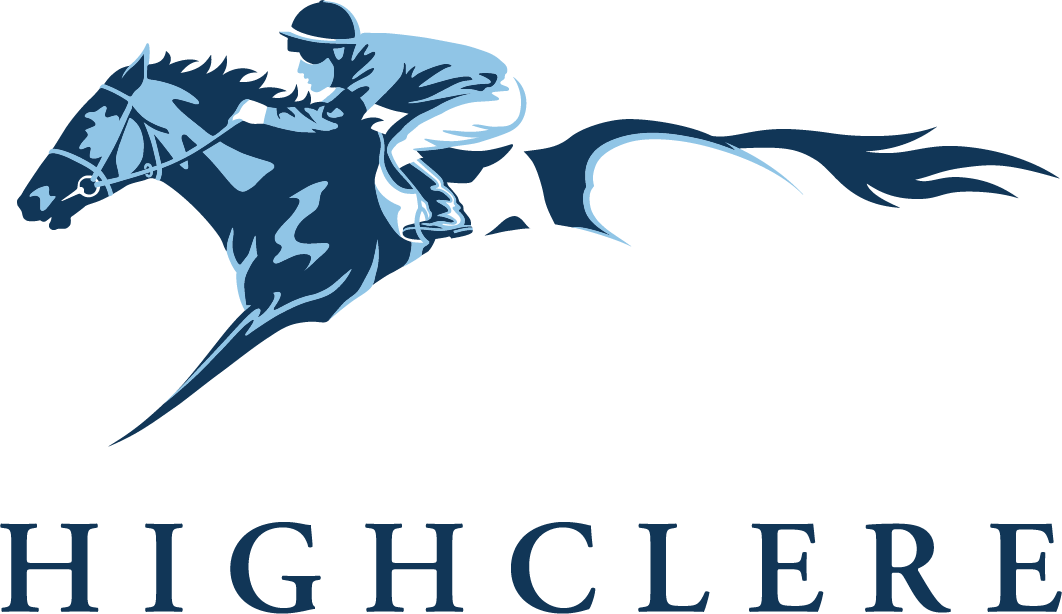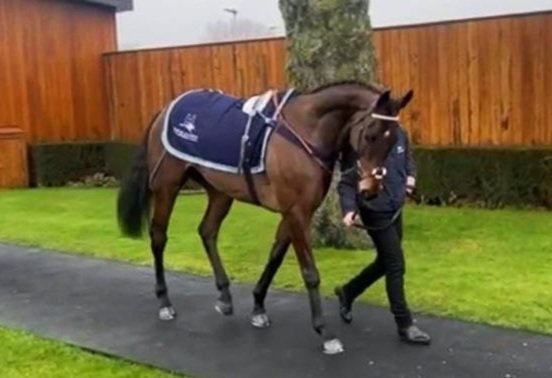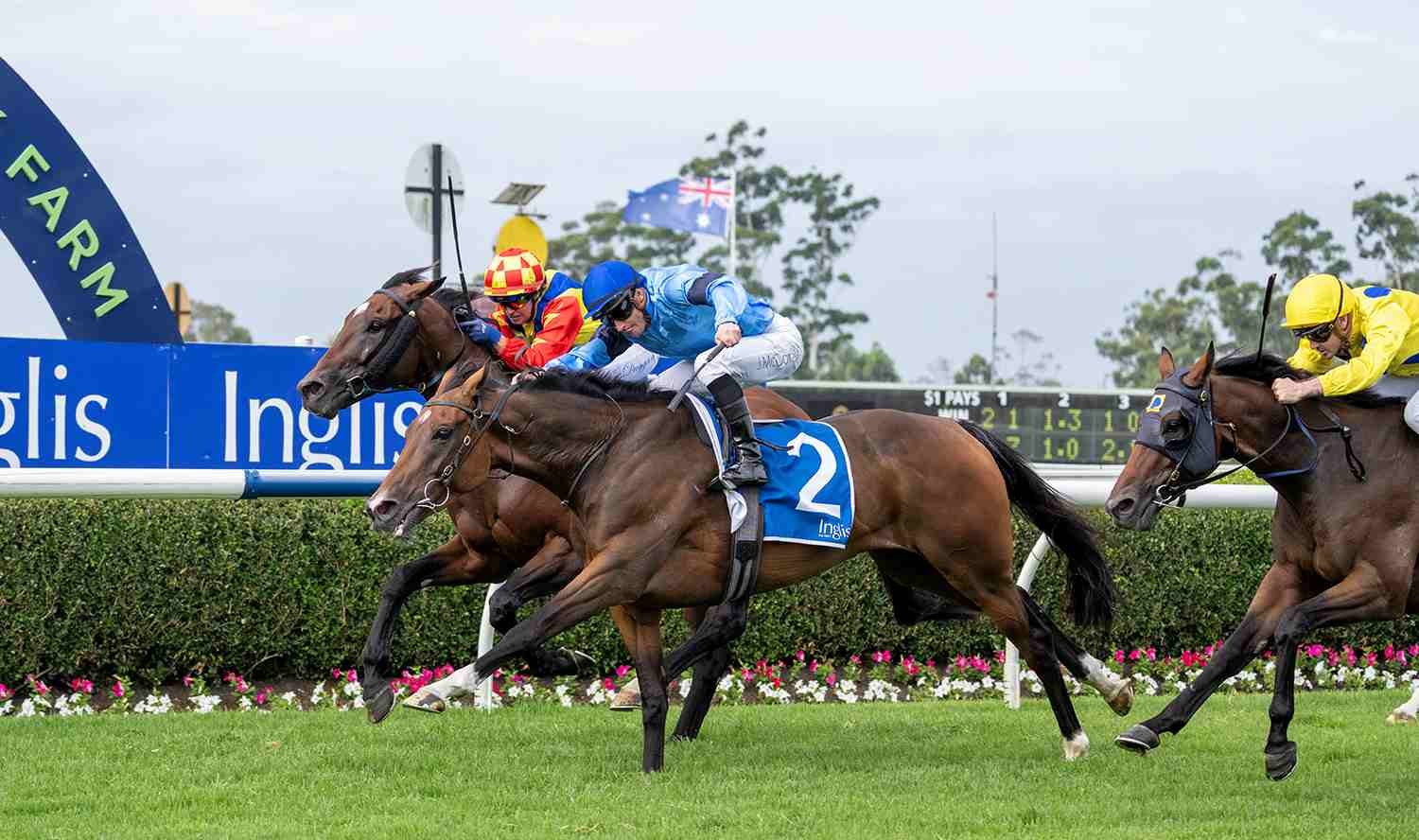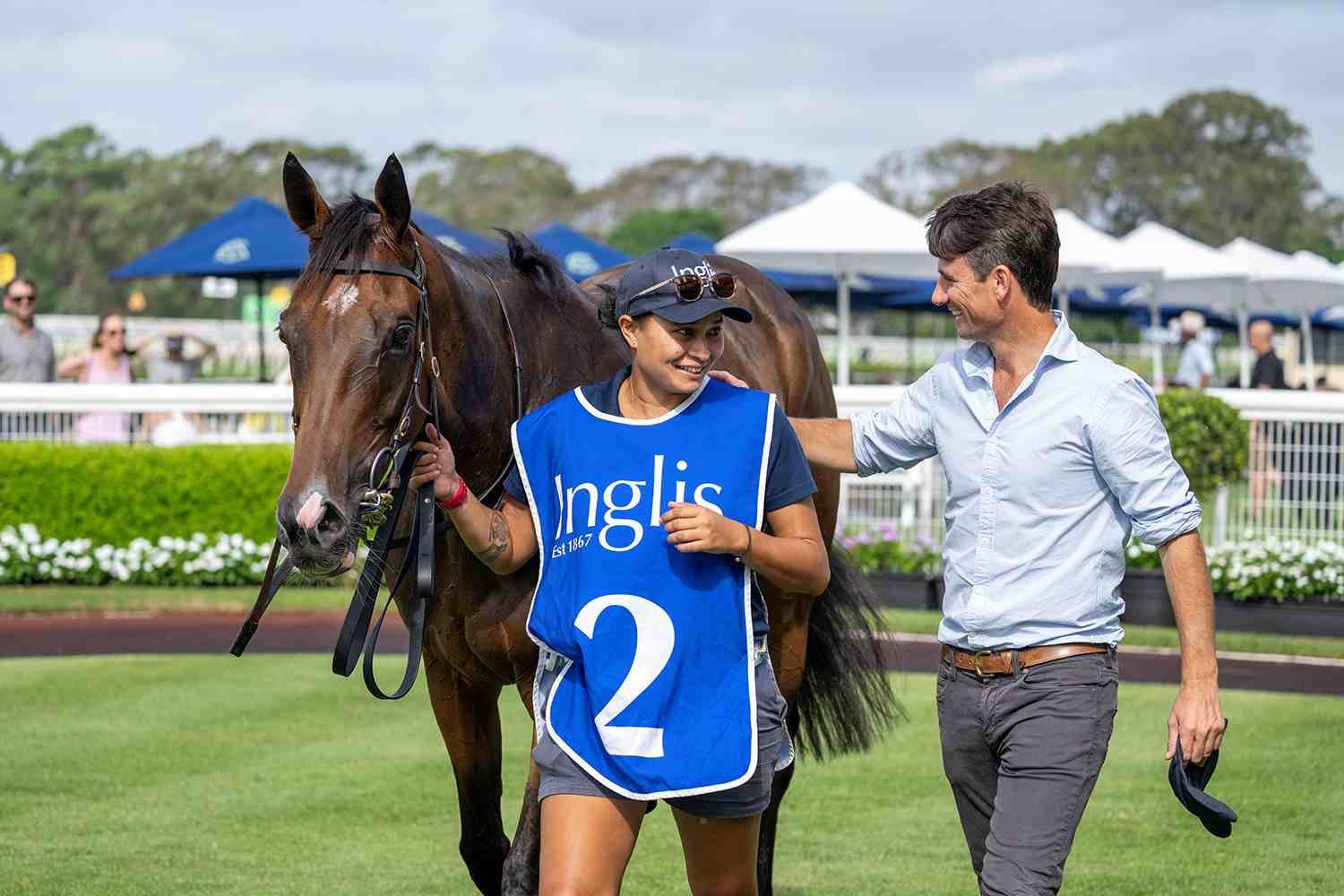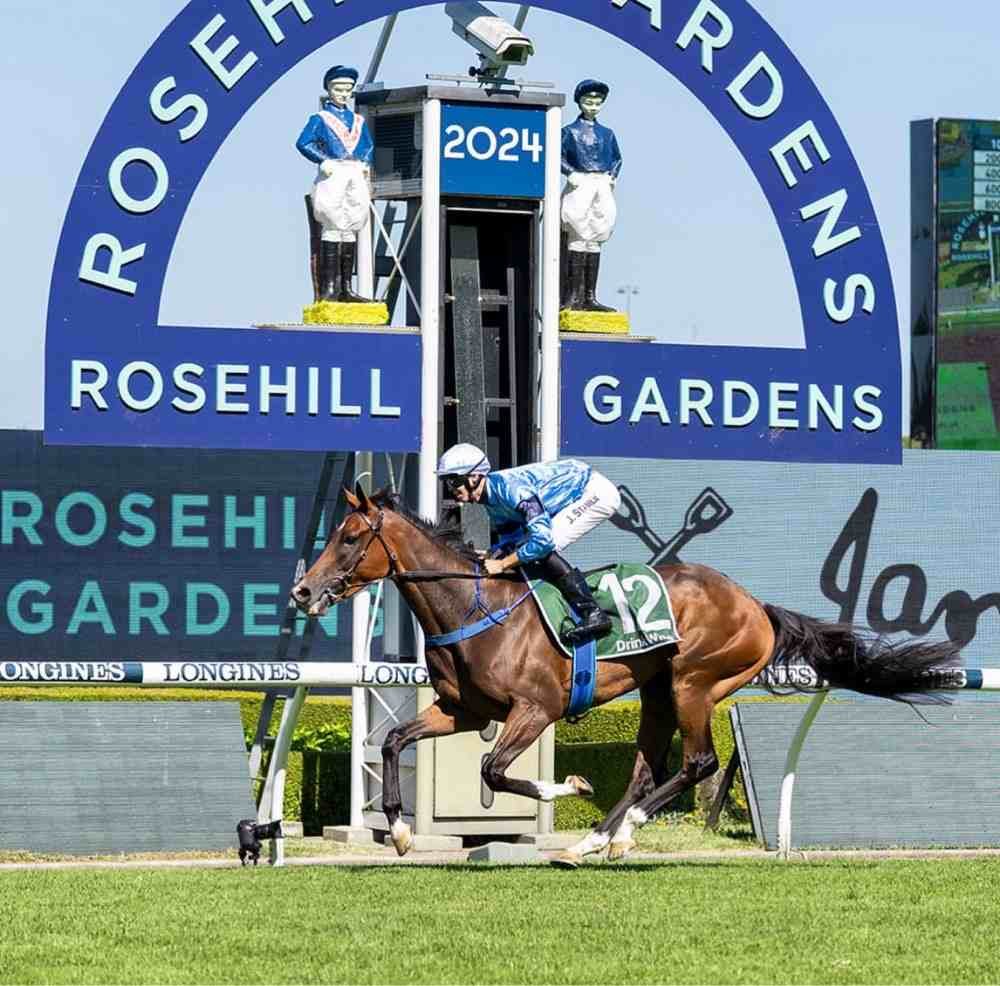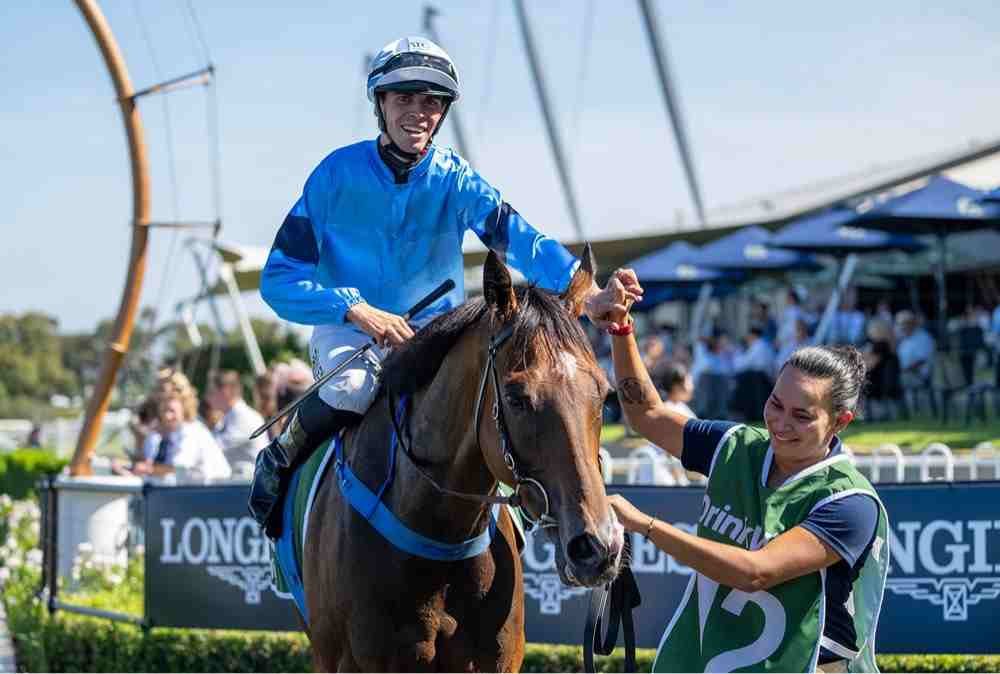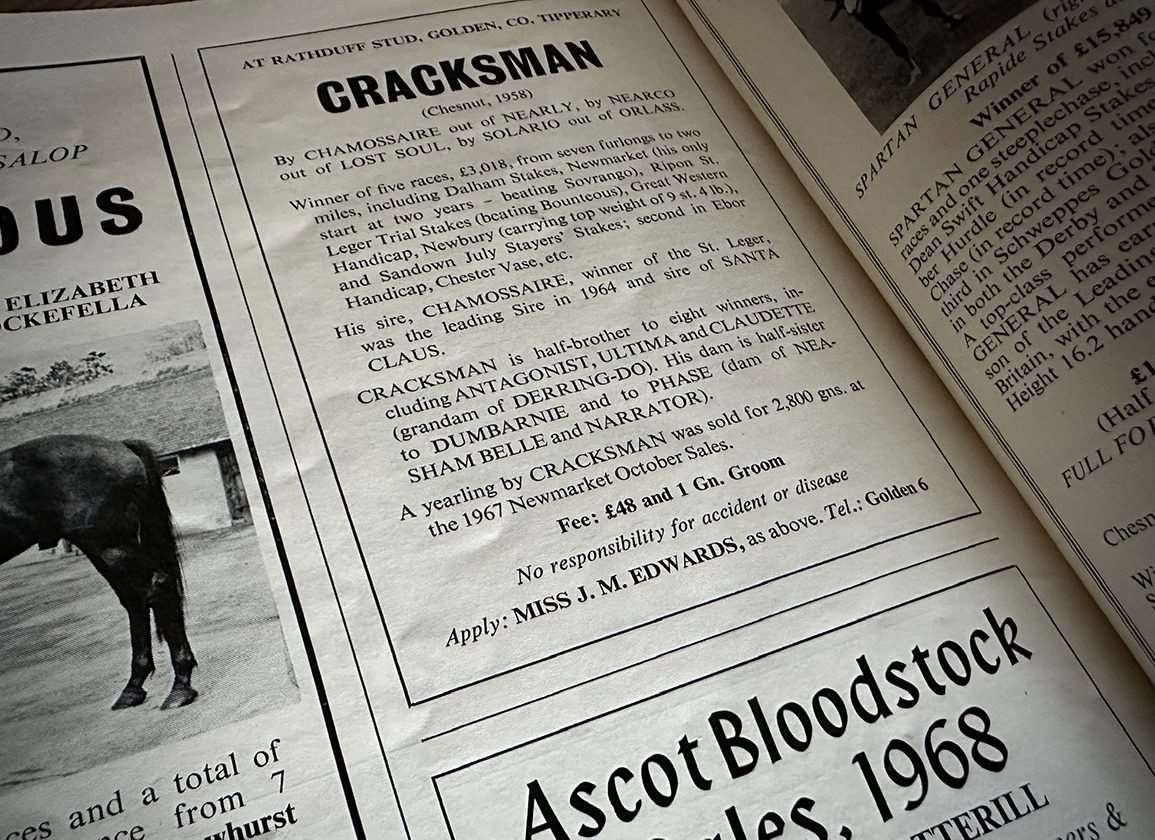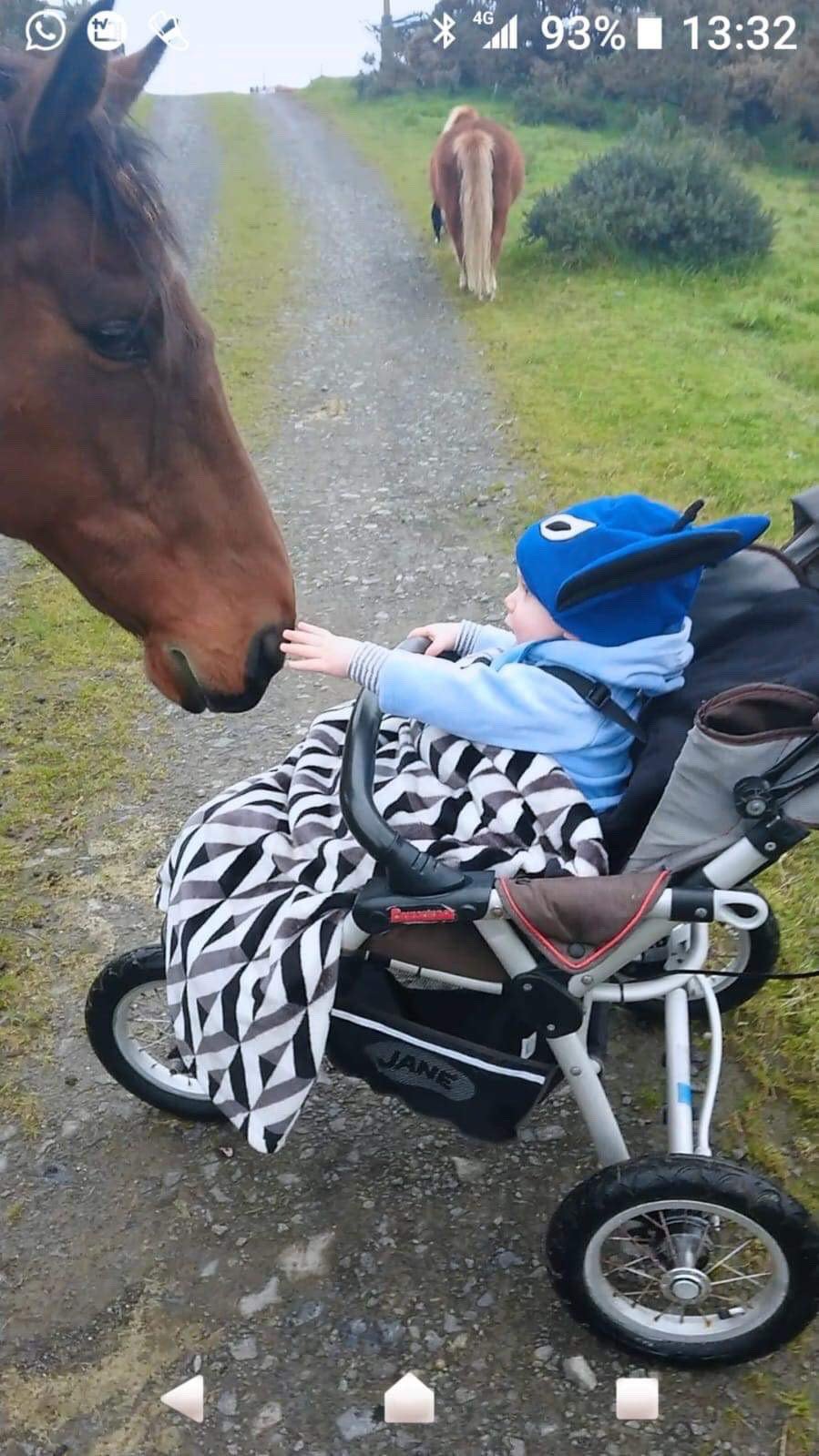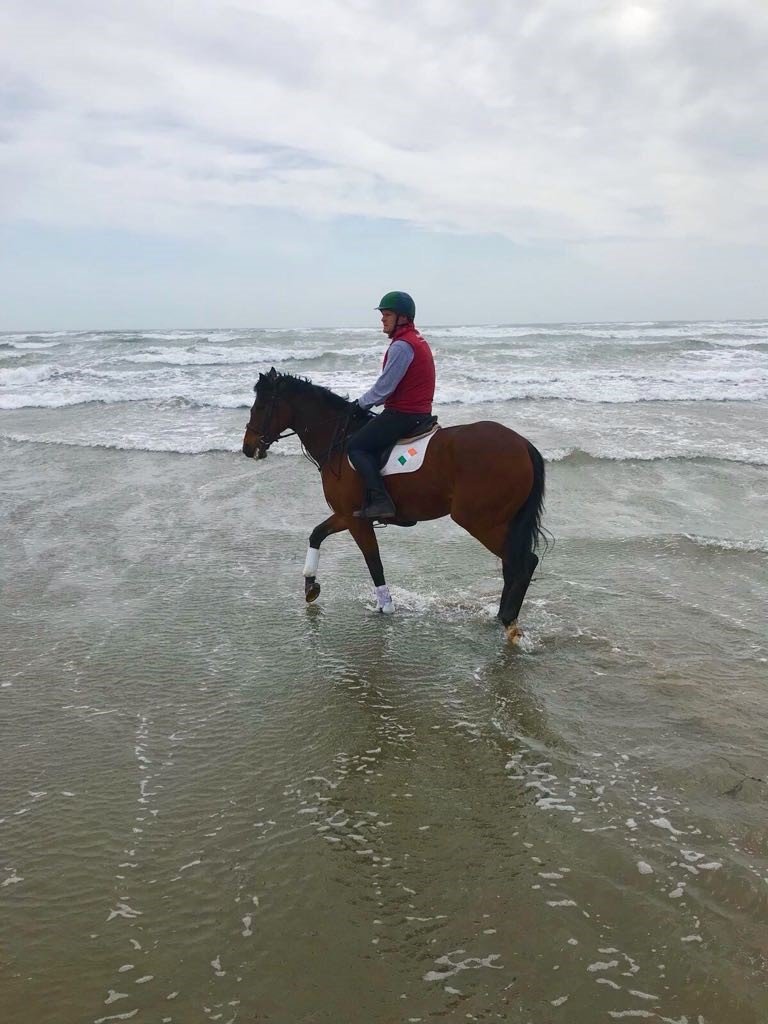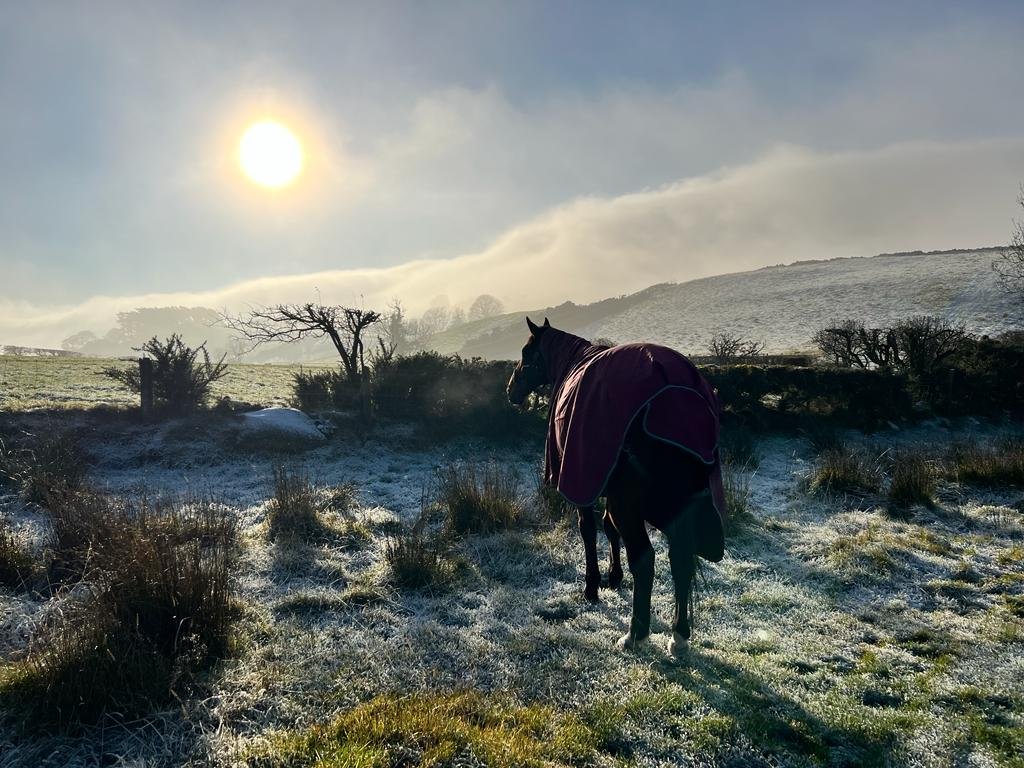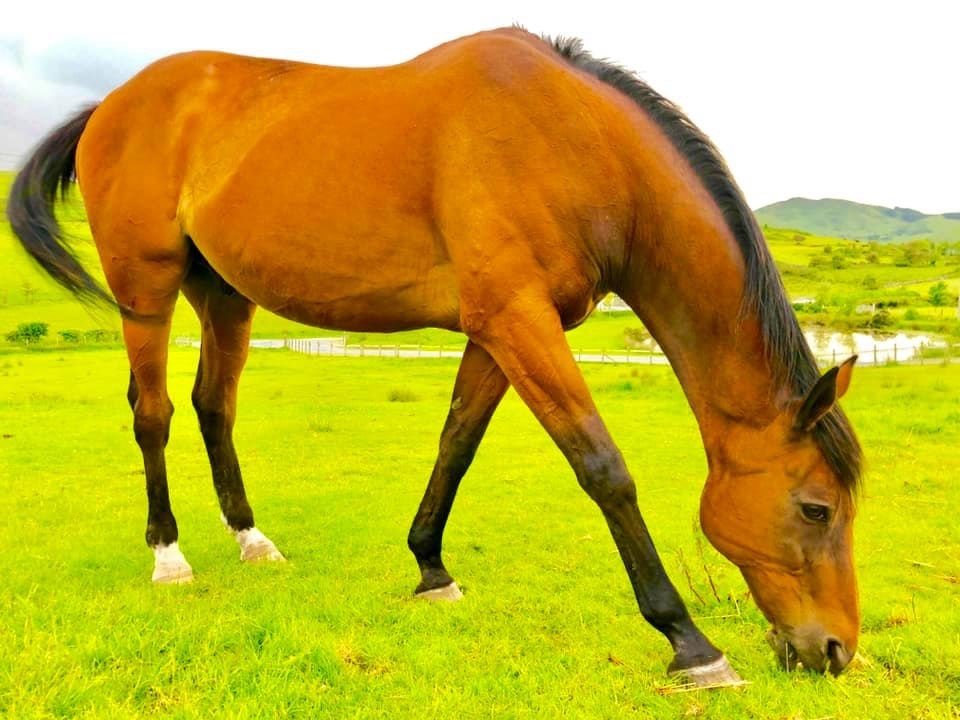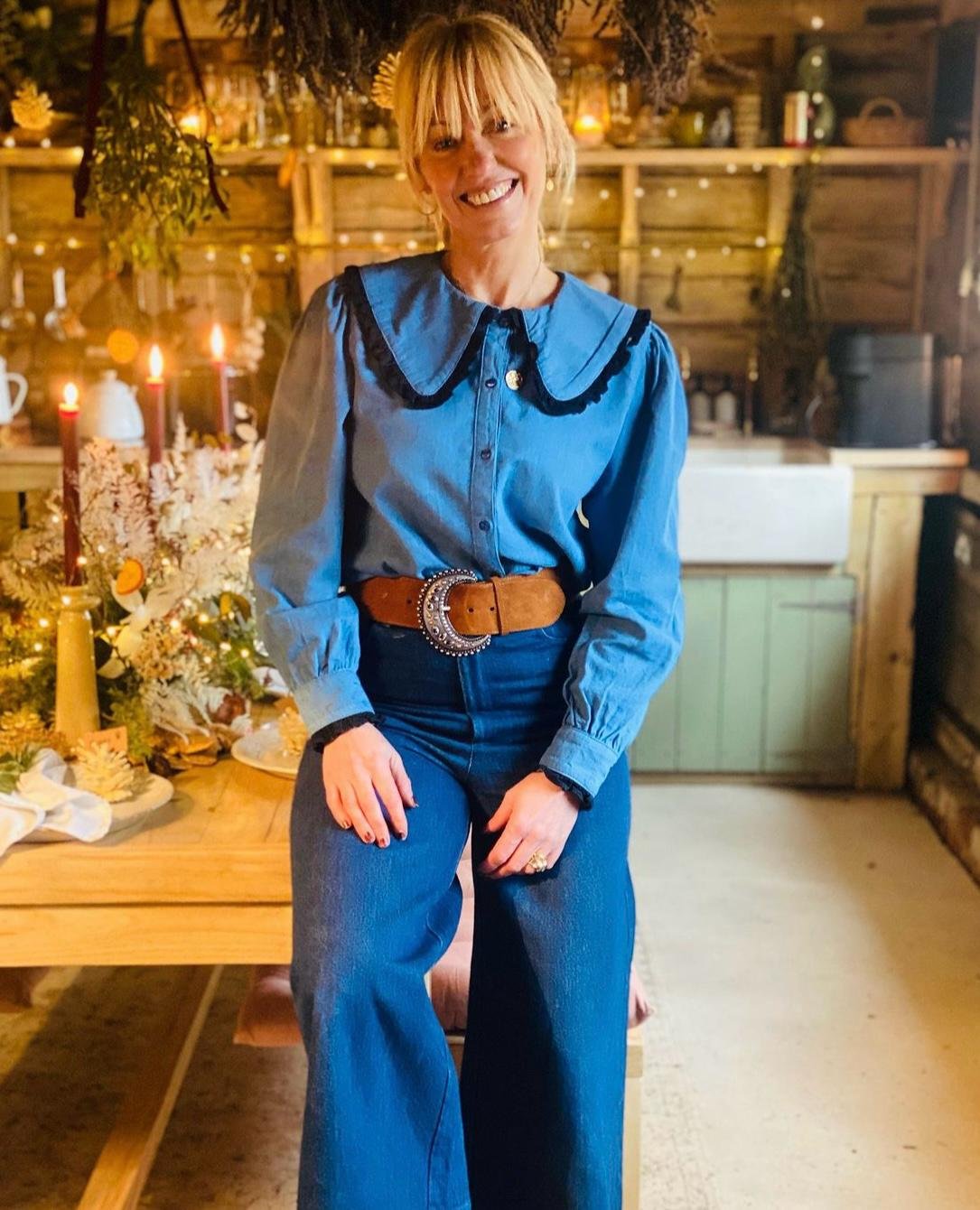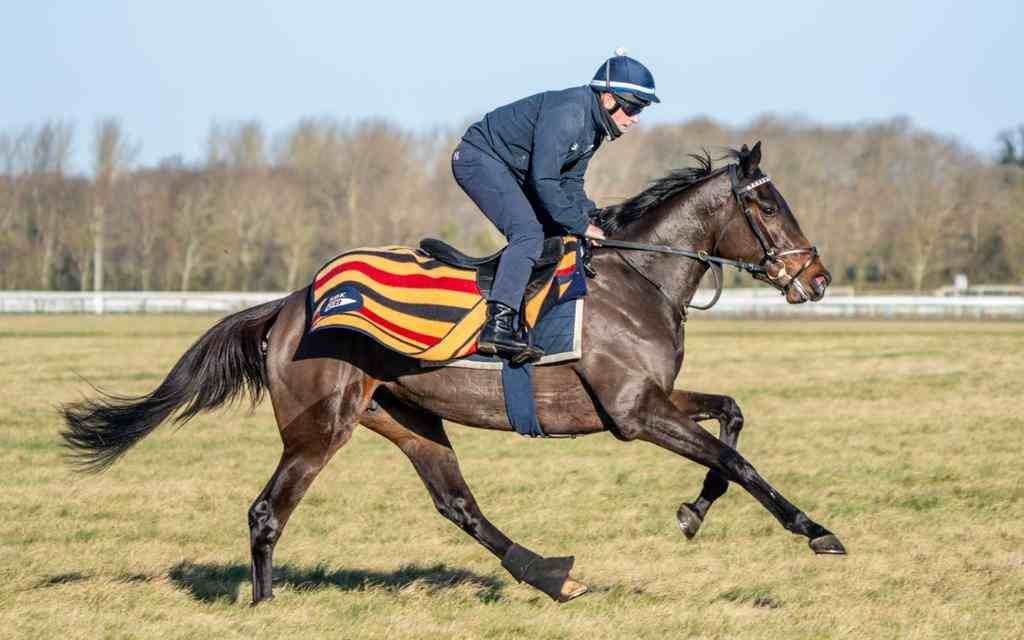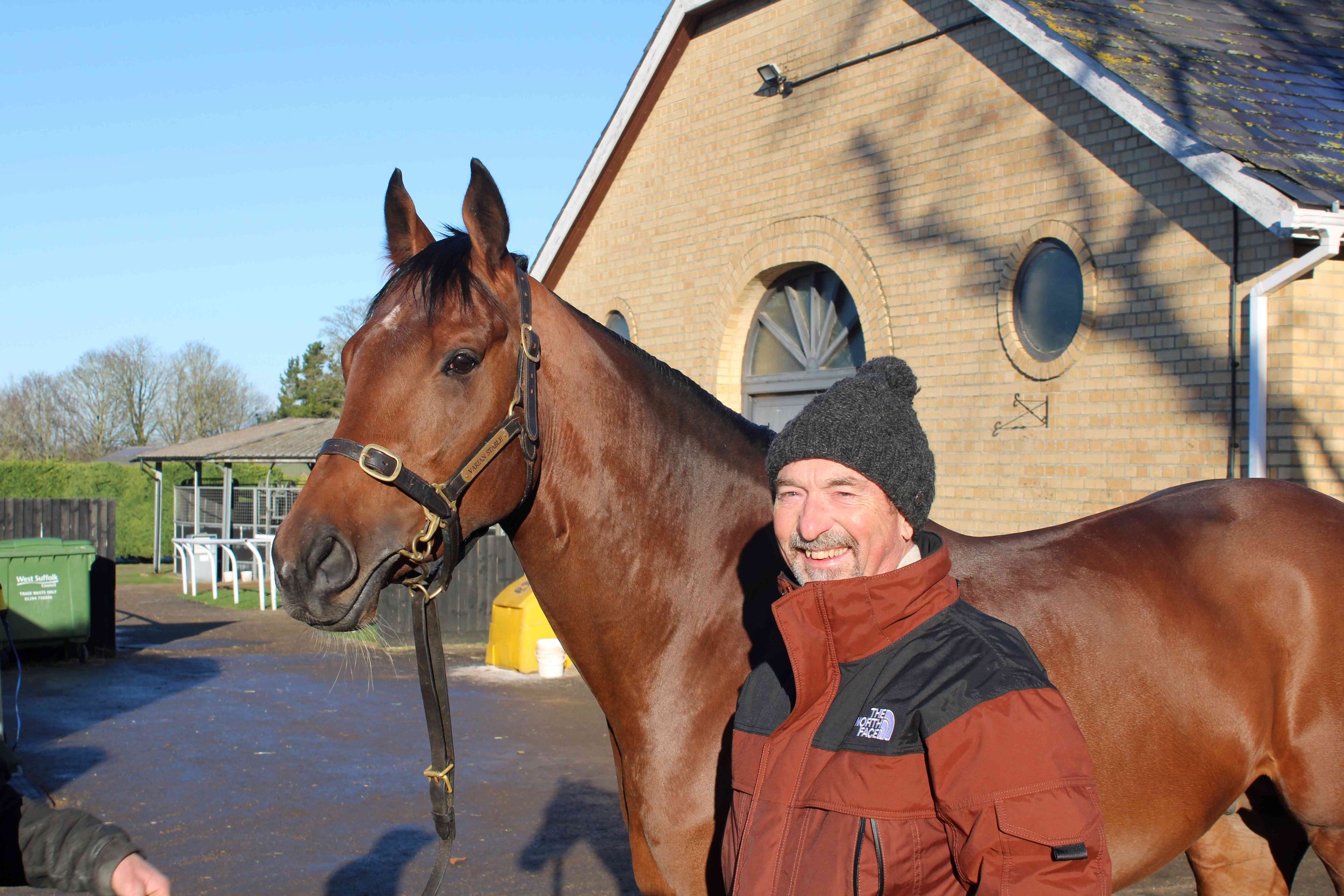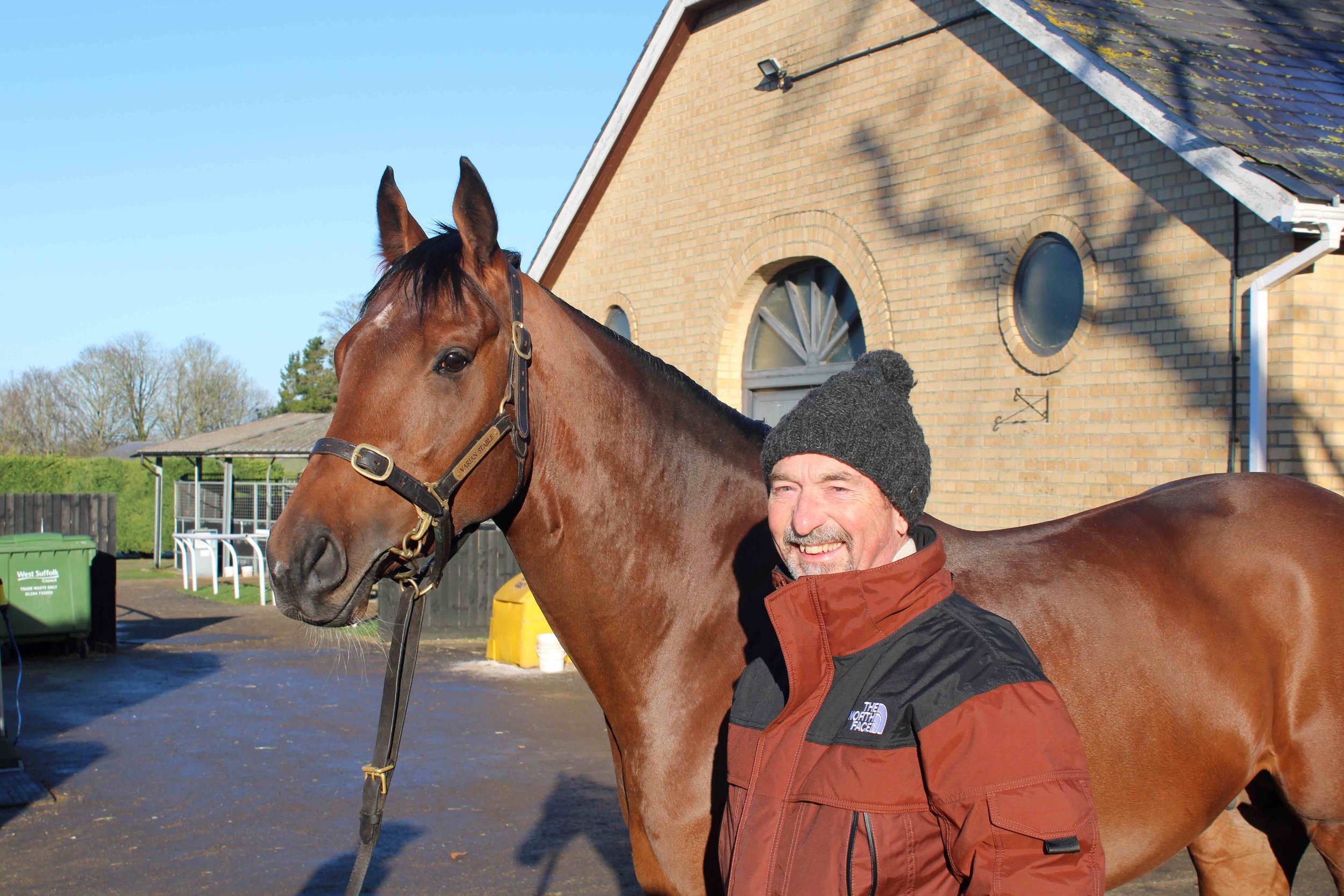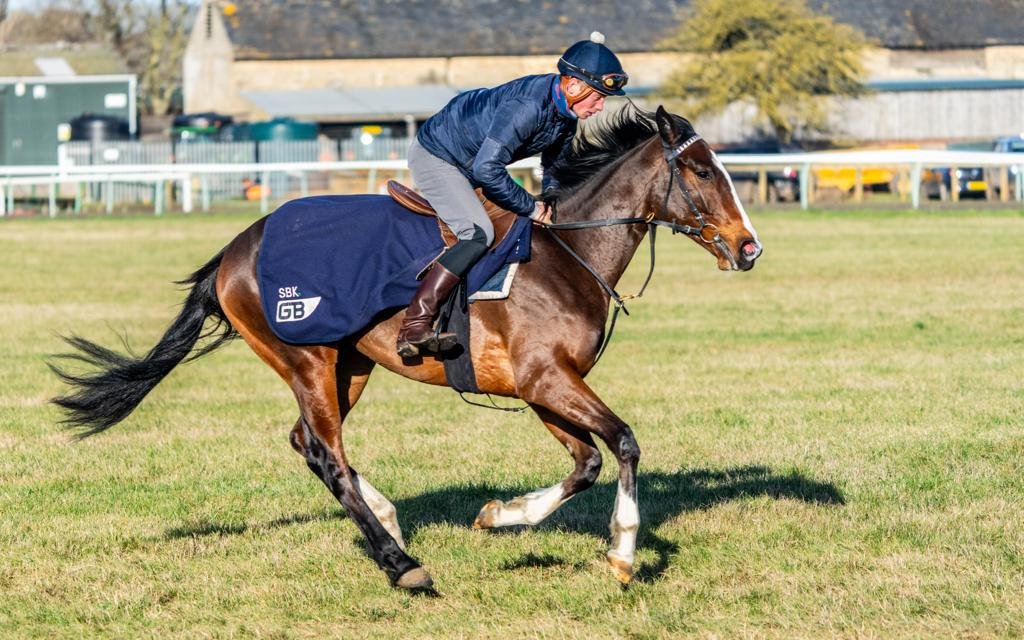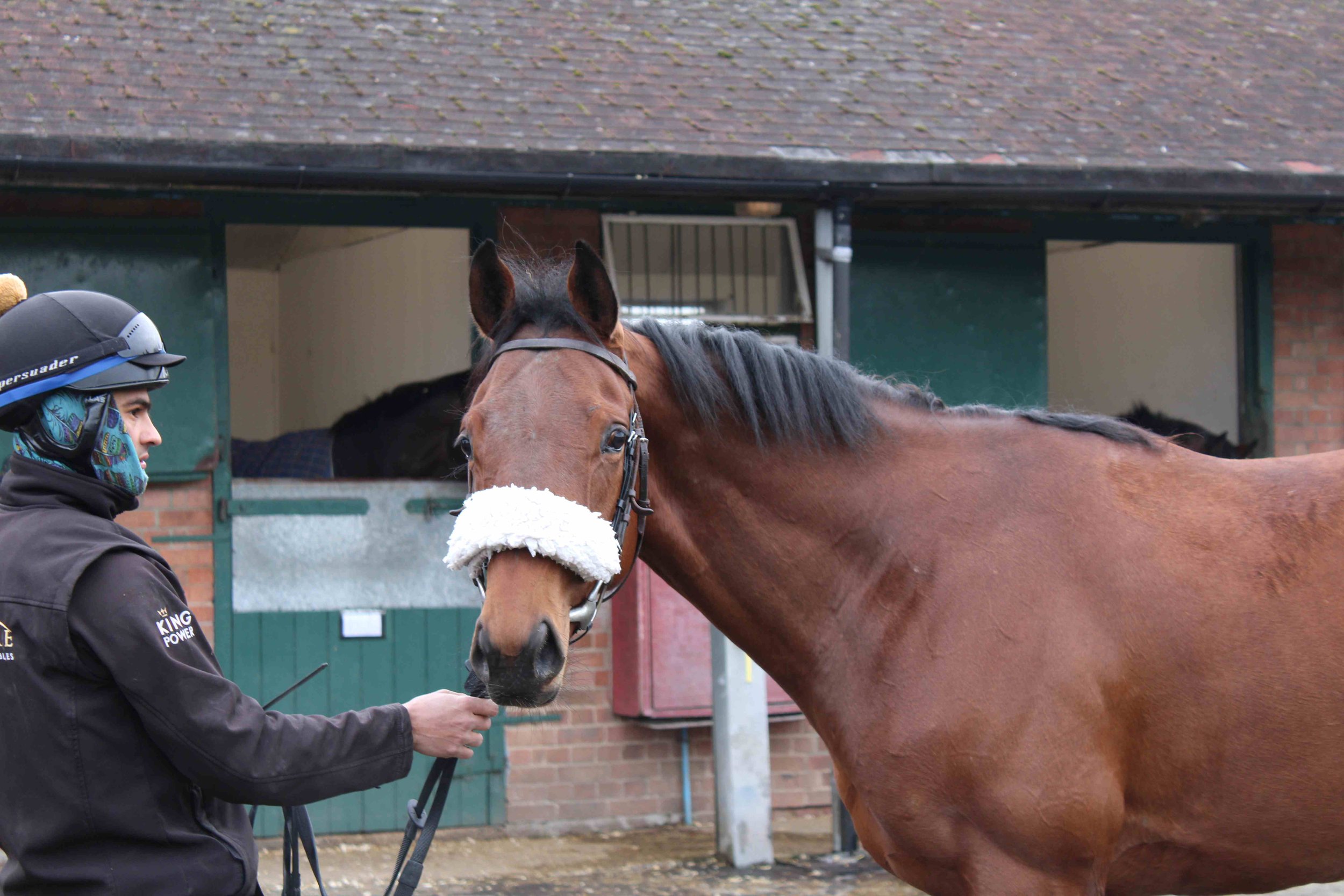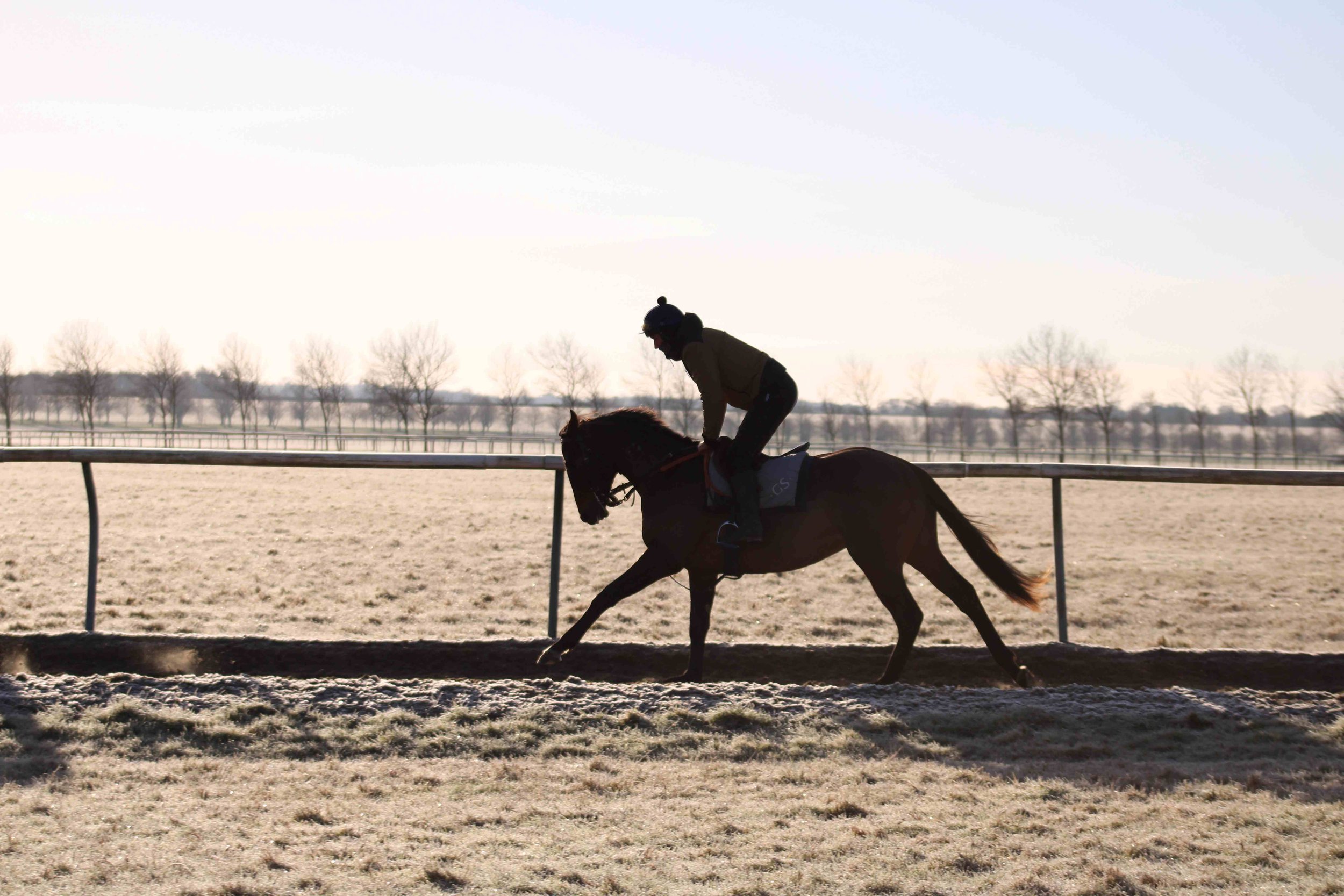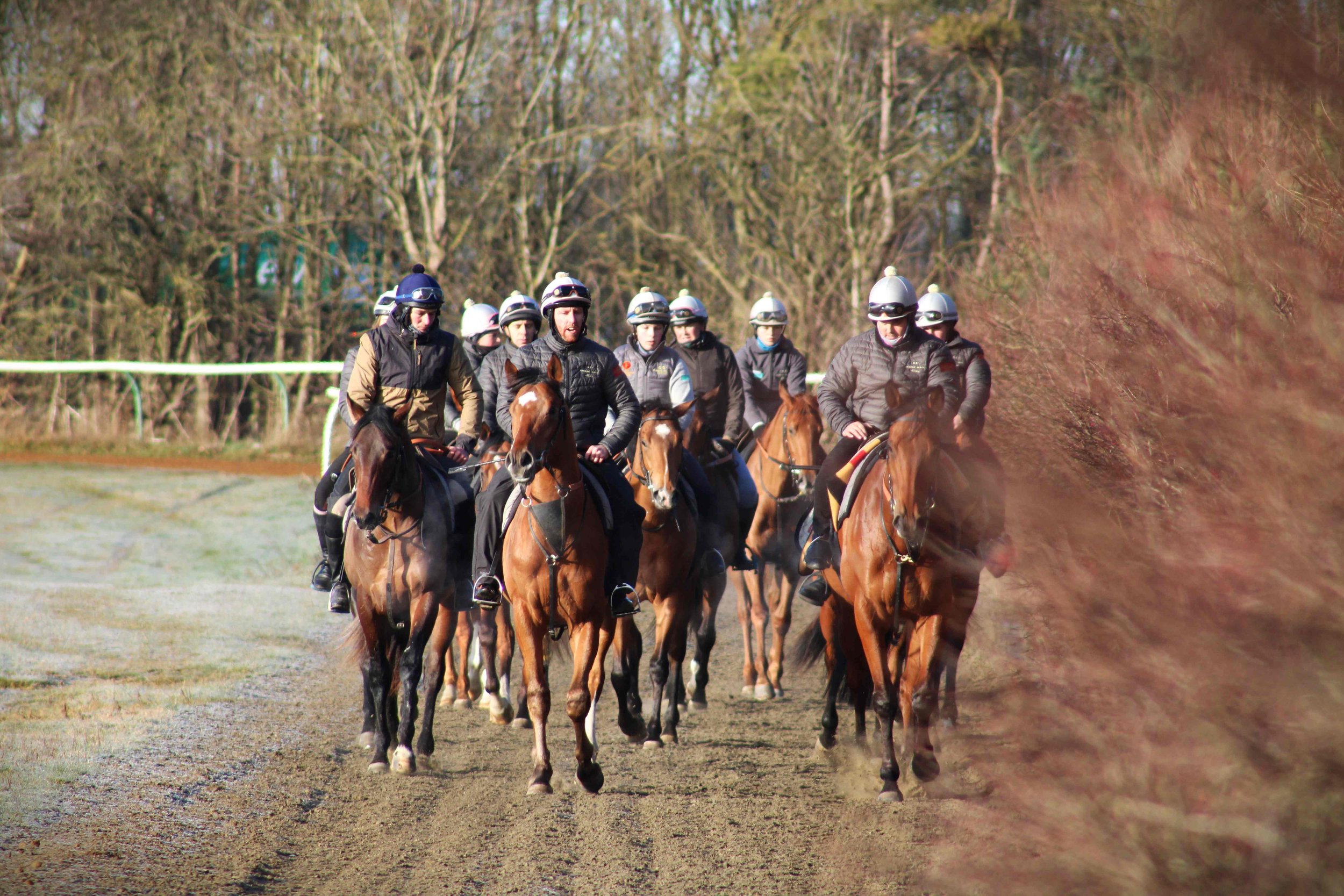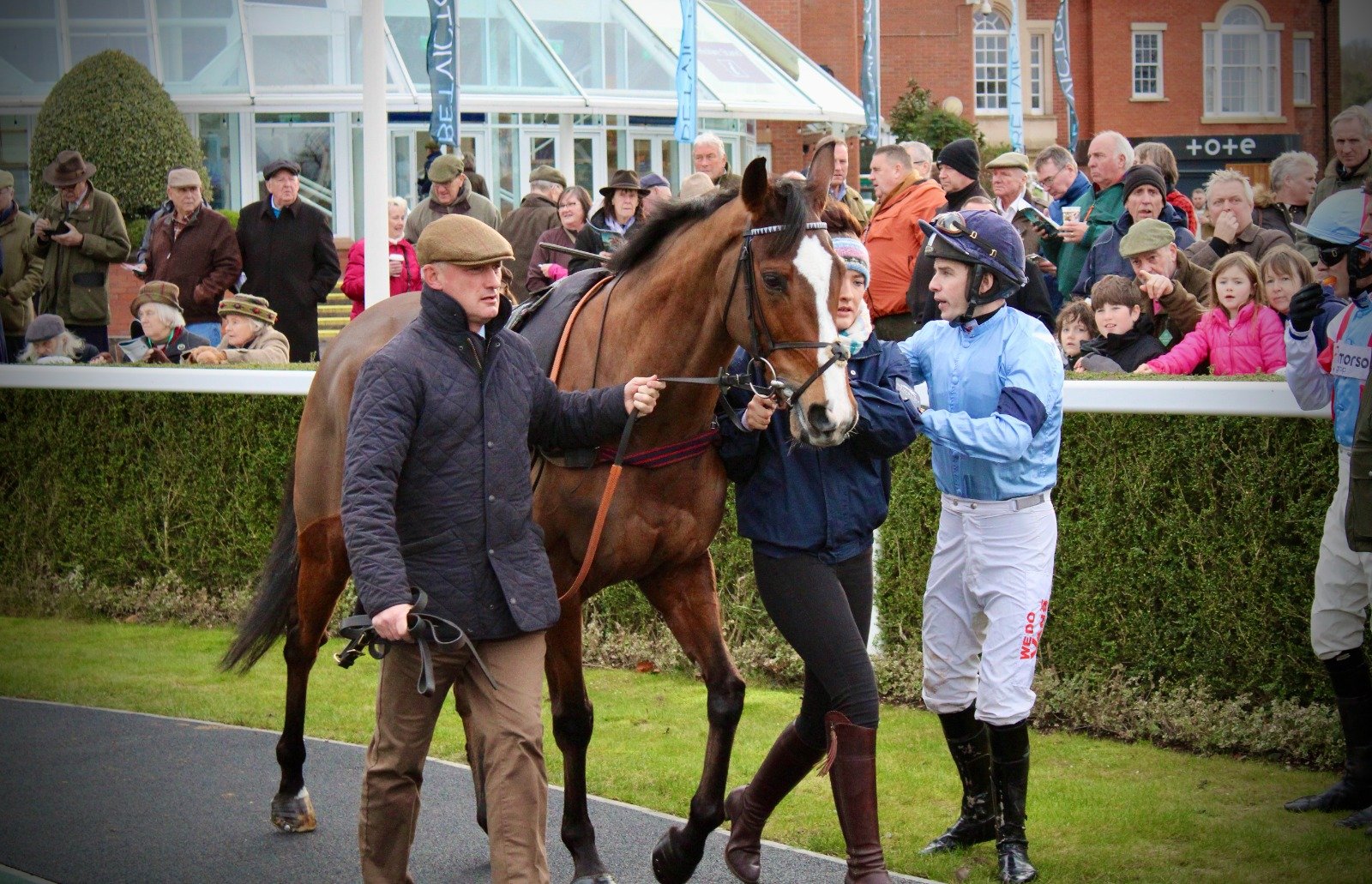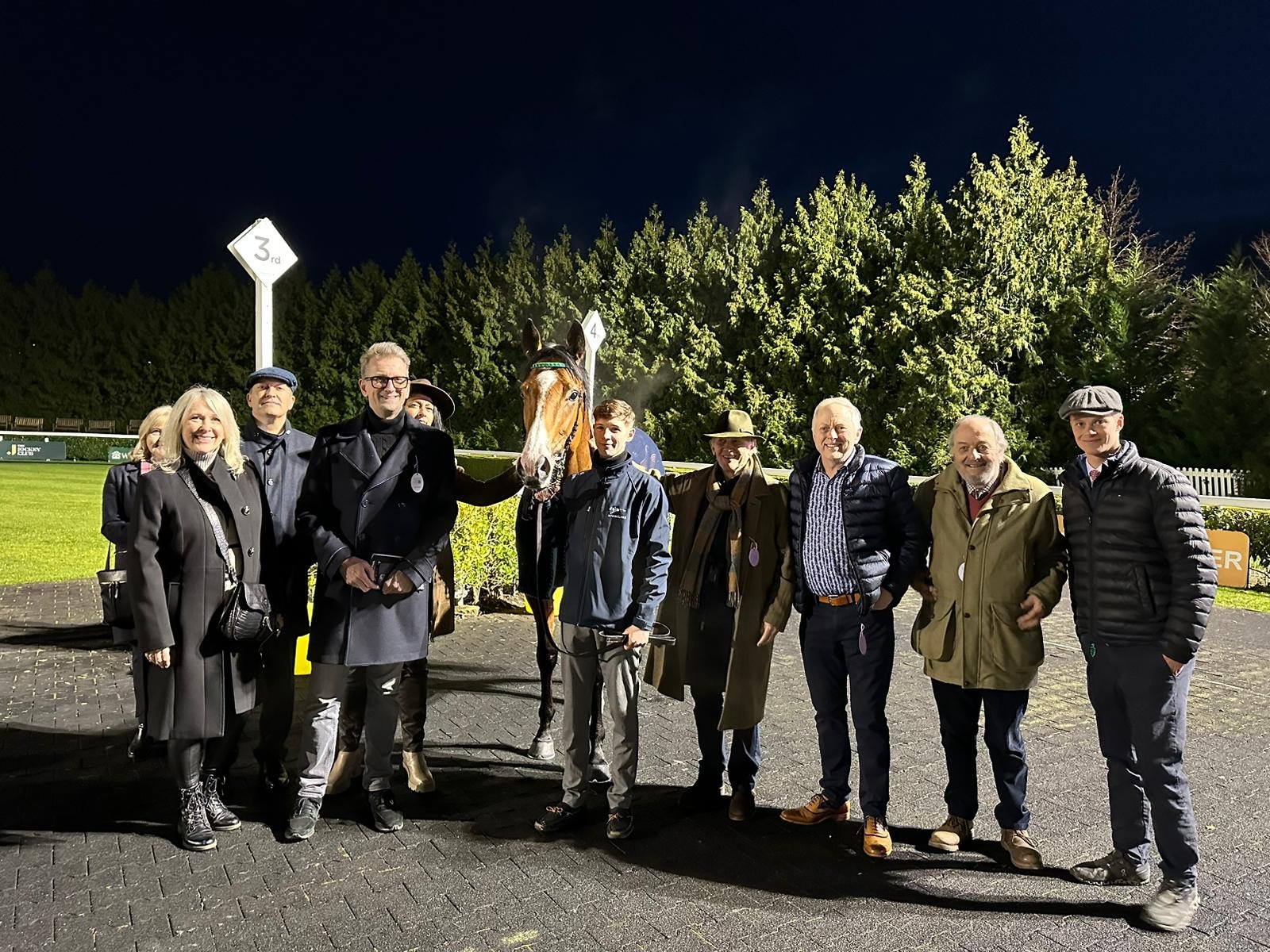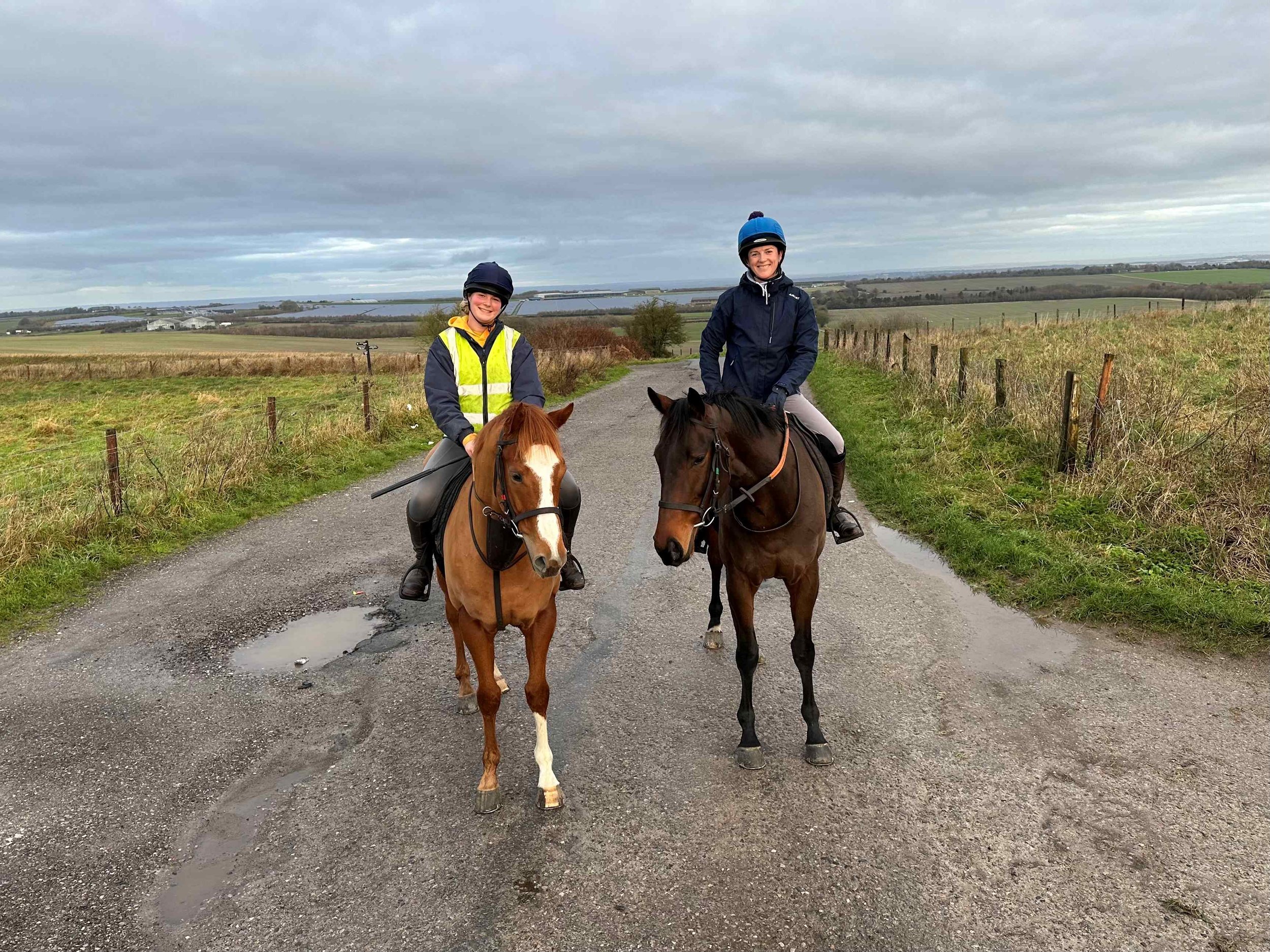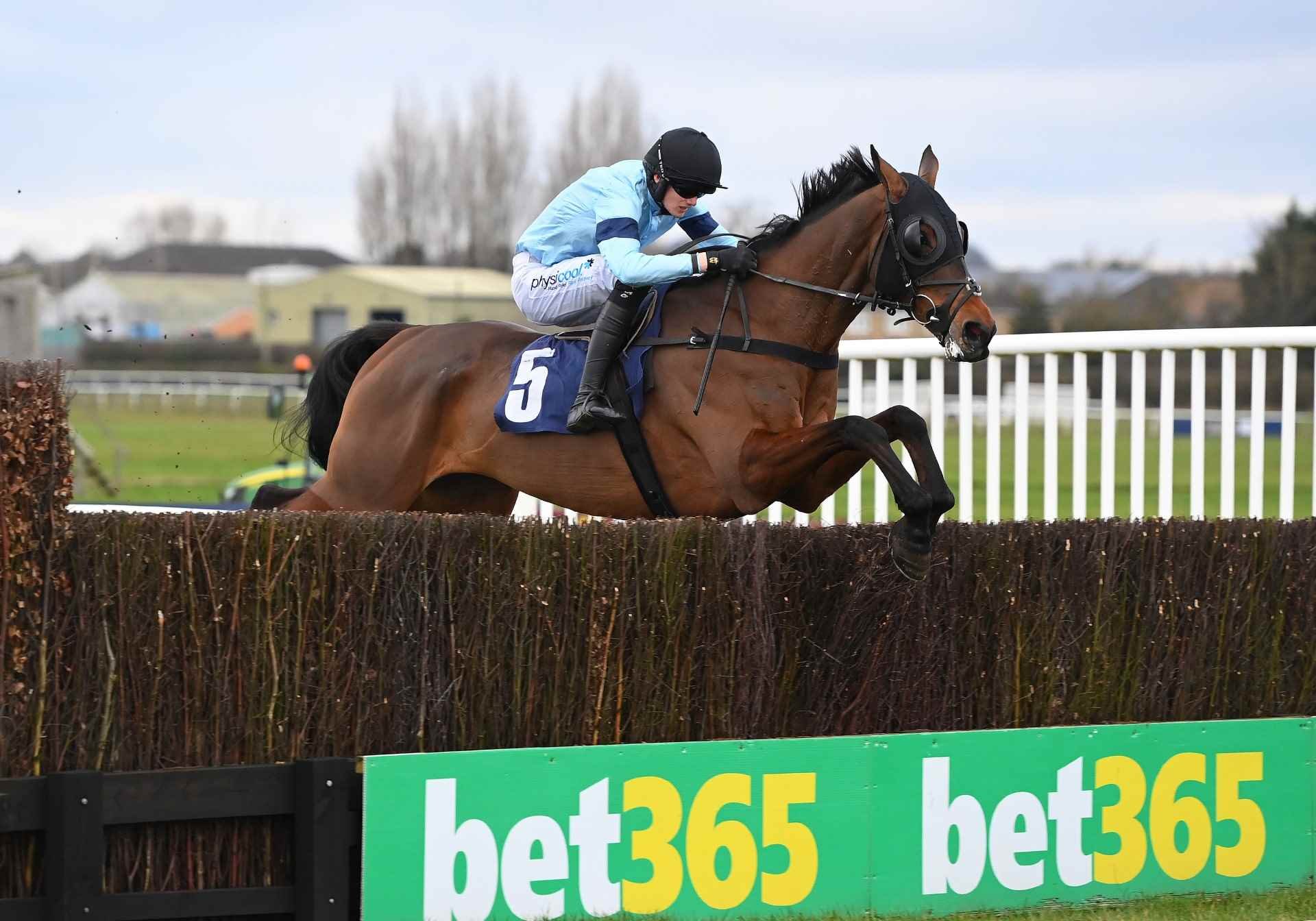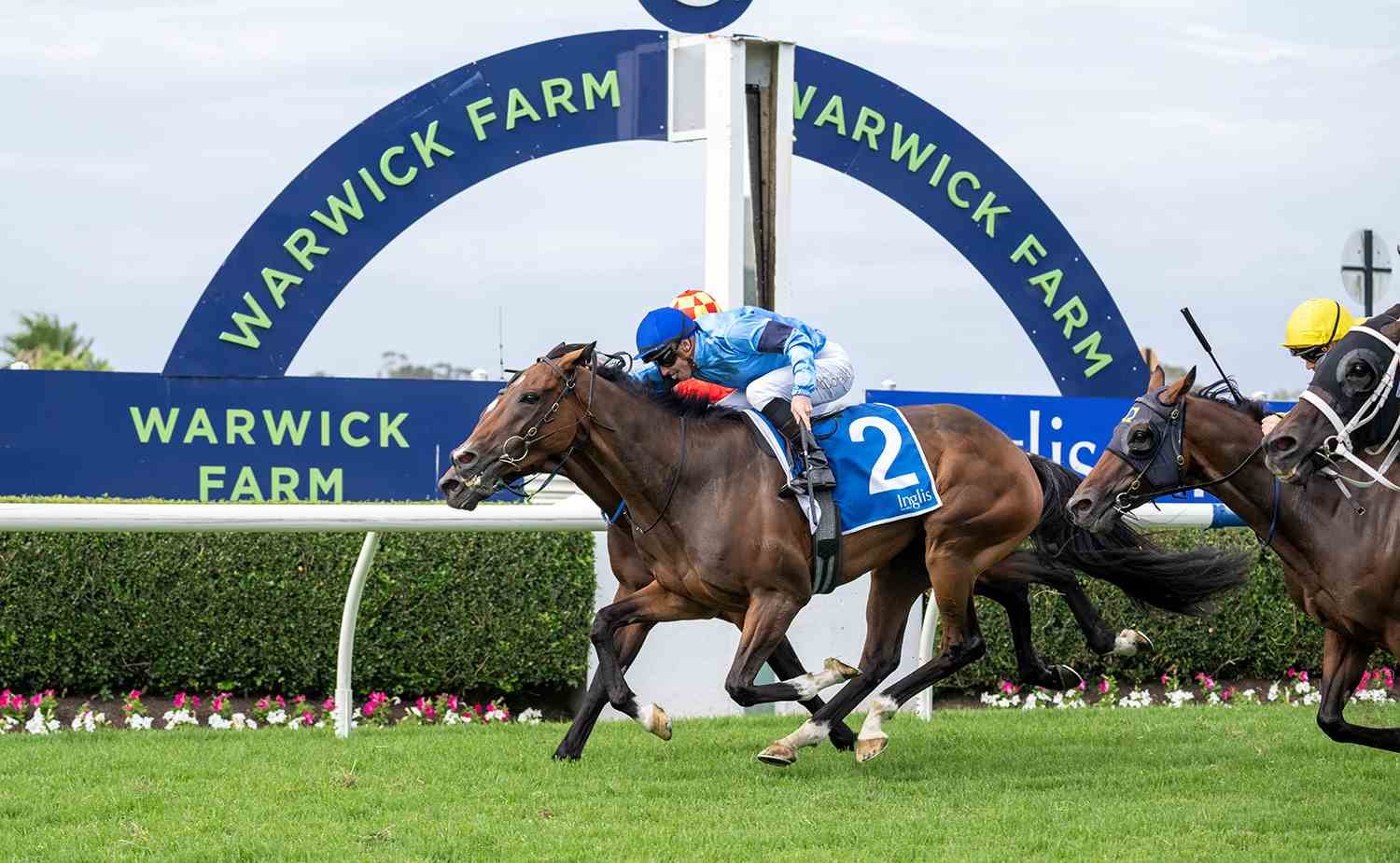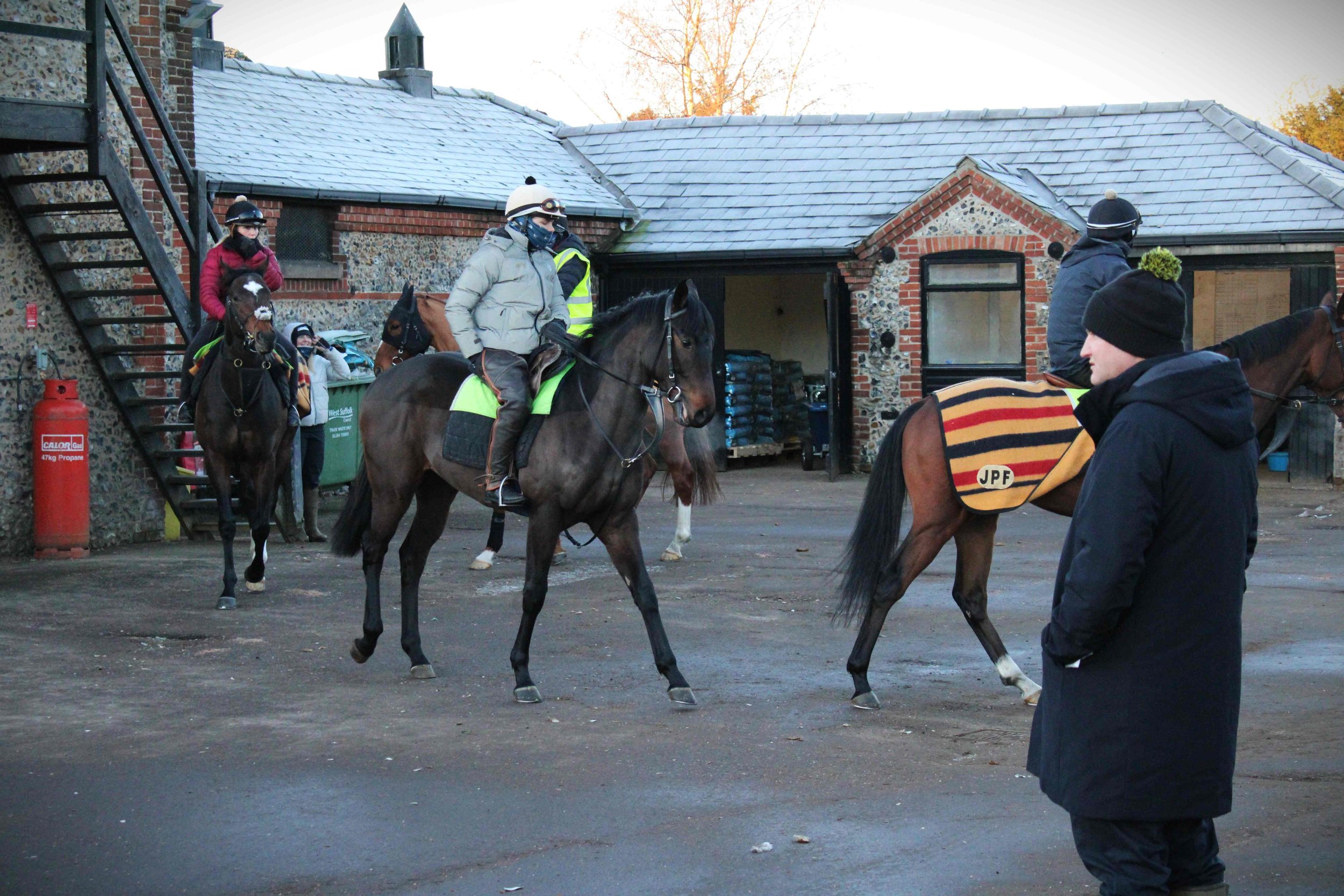JANUARY 2024
Prankster on the Round Gallop, Racecourse Side during a chilly Newmarket visit
By Harry Herbert
I do hope that you enjoy this newsletter. I am very grateful to Emma Berry for allowing us to re publish her brilliant article that she wrote in the Thoroughbred Daily News recently. It’s easy to get caught up in doom and gloom and our industry right now is of course full of it but this article puts a few things into perspective and for those of us with our “cups half full” it offers cheer for the future! You can subside to the TDN for no cost by going thoroughbreddailynews.com or by downloading their app in the App Store. My old boss in America, Barry Weisbord, started the TDN when fax machines first came into operation as he thought that everyone would want immediate Bloodstock world news on a daily basis. I was working for him at the time when it was launched but sadly he got a poor response as it used up so much paper each morning! He was (and still is!) a man way ahead of his time and when emails were invented he relaunched and now the TDN is the most read daily news feed for the thoroughbred industry worldwide. A case of try, try and try again!
As you will see in this edition we have had some success on the racecourse with our jumpers as well as in Australia where Naval College, bred by the late Queen, won the Australia Day Cup and added another $109,000 to his prizemoney haul which now stands around the $450,000 mark!
Next week sees the start of our stable visits which always gives me and my team a real buzz of excitement and anticipation as the flat season draws ever closer. Not long now!!
With my best wishes,
Harry Herbert, Chairman
On The Track
By Emily Scott
Mount Tempest is proving himself to be the star of our National Hunt season having posted his second consecutive victory at Wetherby in mid-January. Once again, his jumping was his biggest asset as he made virtually every yard of the running and gained a sizable advantage from the back of the last to win with ease by 8 lengths. He backed up two weeks later at Sandown where he suffered quite bad interference from a loose horse as the field had to by-pass the pond fence, which all but stopped him in his tracks. He may not have won, but he certainly would have held on for second, however, he lost little in defeat and will now be freshened up before Dan Skelton plots his next target.
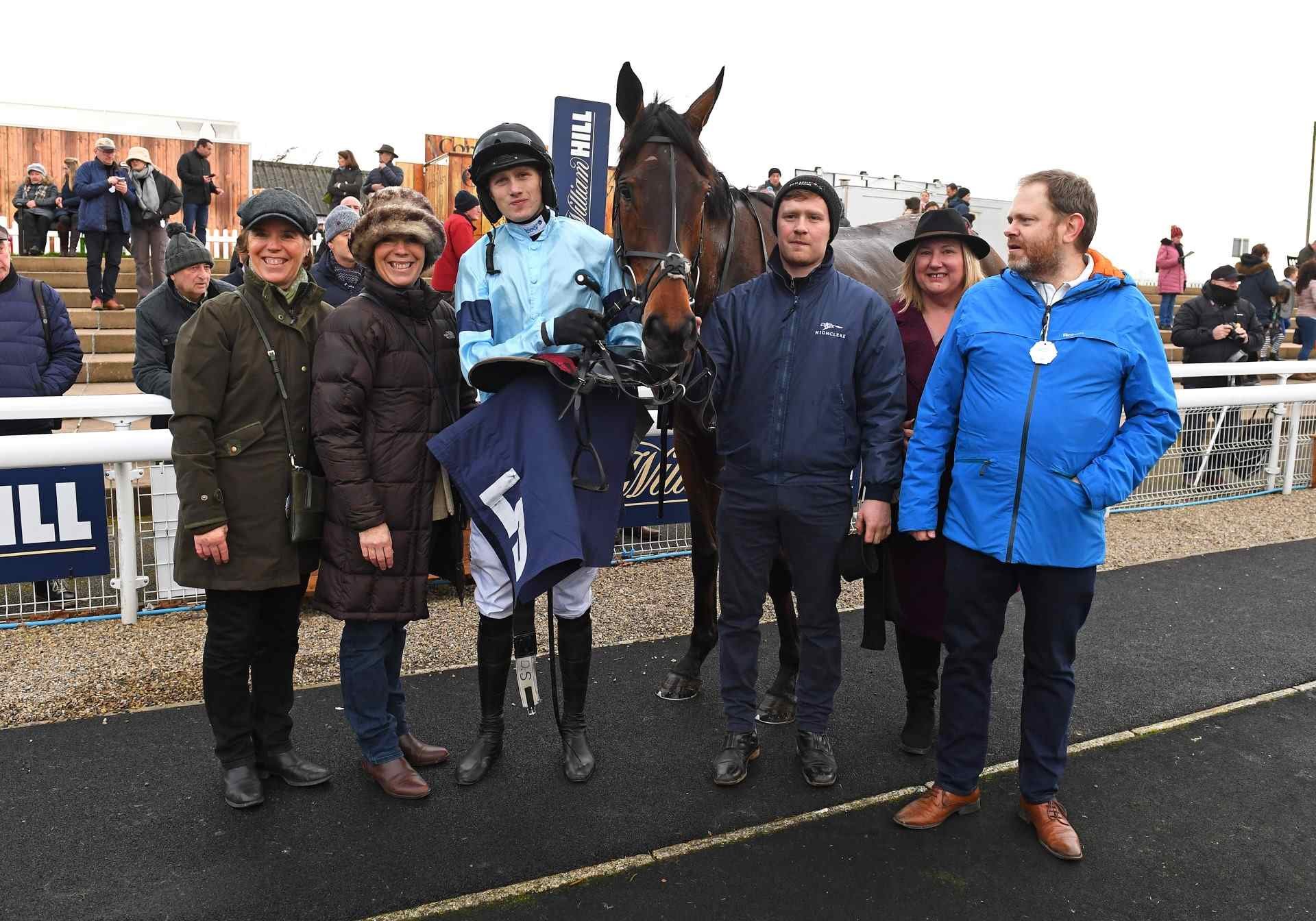

Owners of Blairgowrie were given a great thrill as he returned from a 662-day absence to finish second at Newbury last week. A gorgeous big horse, he was unfortunate to suffer a freak accident in the yard soon after he won over hurdles in April 2022, and we have a lot of people to thank, namely his trainer Nicky Henderson, for getting him back to the racecourse in such fantastic condition. He got a bit tired on his return to action, which was to be expected, and this caused his jumping to suffer late on, but he will be straighter next time and should have every chance of going one better.
Pulling Stumps at Newbury in December
Blairgowrie Newbury Novices' Handicap Chase January
Our ‘nearly’ week last week continued with Pulling Stumps, who jumped like a buck at Chepstow and looked to have the race at his mercy when taking a crashing fall two out. It was a shame for the horse because he really looked to have honed his jumping and was racing with loads of confidence before he came down. Hopefully that experience will not dampen his enthusiasm as he looks to be a nice prospect for staying chases going forwards.
The flat action for the year began last weekend at Kempton where Suspicion made a highly promising debut in a mile maiden where two Godolphin Dubawi hot pots dominated the betting. He was Highclere’s first runner for young trainer Ollie Sangster, who warned that Suspicion was likely to be green on debut. As it turned out he behaved like the consummate professional throughout proceedings and only went down by a length and a quarter to the strongly backed favourite, Silent Age. He would be one to follow wherever he goes next as I’m sure he will go very close now he’s got a run under his belt.
Suspicion with his owners in the winners enclosure at Kempton, taking 3rd place in the Unibet Supports Safe Gambling Maiden Stakes
It’s been another successful month down under as Naval College recorded a hat-trick following two more wins since our last newsletter. His latest victory, which came in the Listed Australia Day Cup at Warwick Farm, takes his career earnings to $472,336. It was a brave performance under a big weight and a brilliantly executed ride from top jockey James McDonald. His future will be in Group races now and let’s hope he continues to climb the ladder to develop into a serious Melbourne Cup contender.
Our latest Australian import, Redstone Well, ran twice this month; finishing an encouraging fifth on debut over 1400m and building on that next time out to finish second over 1600m. This horse will continue to improve as he steps up in trip and nice to be able to pick up a cool $29,200 on his way there!
Visits
by Frances de Haan
This month the team have predominantly been busy visiting all your horses to catch up with them since the Christmas break. We ventured to Andrew Balding’s and also Newmarket for the first trip of the year, braving Warren Hill for a couple of beautiful yet frosty days (-8 one morning). You will have seen the video updates, but we were thrilled to see how well all your horses have done.
The three year old and older horses all looked well, those that have had breaks had clearly benefitted from their time away and were all progressing along their winter programmes. With some impressive two year old results already under their belts it will be exciting to see how they perform as their three year old campaigns get underway!
The two year olds have settled into their ‘new schools’ and it was fantastic to see how well they had all done over a short space of time. Despite it being below freezing temperatures, as the two year olds trotted in their string, or completed their steady canters up Warren Hill we could almost taste the Spring and the start of the racing season. It is remarkable how much they have grown, matured and developed in a few weeks, some of them looked like racehorses already, blending in to the string of older horses, there really are some seriously precocious types among them. The trainers all gave glowing reports, it really is an exciting time and we cannot wait for you to see them for yourselves as the visits get underway in the coming months!
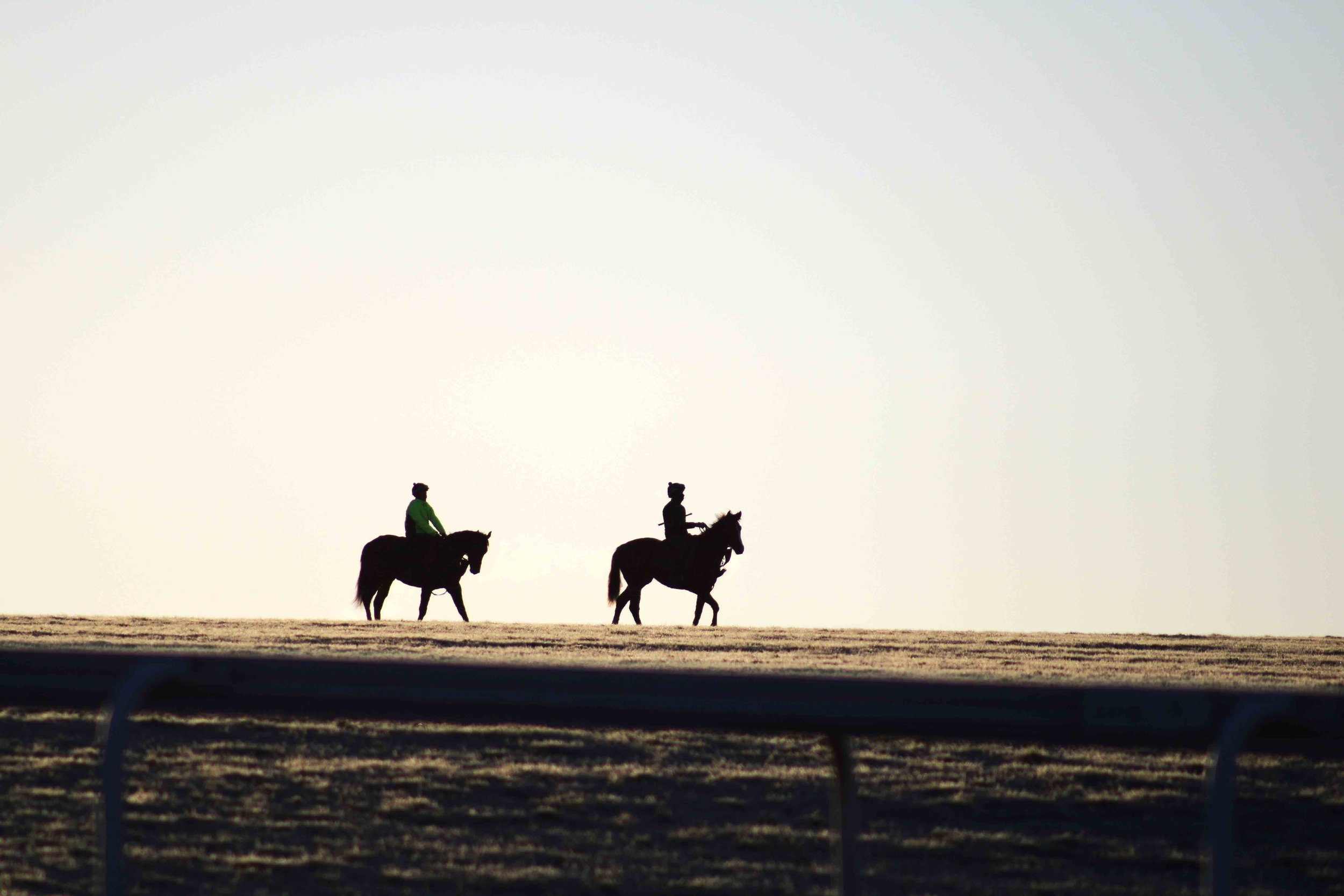
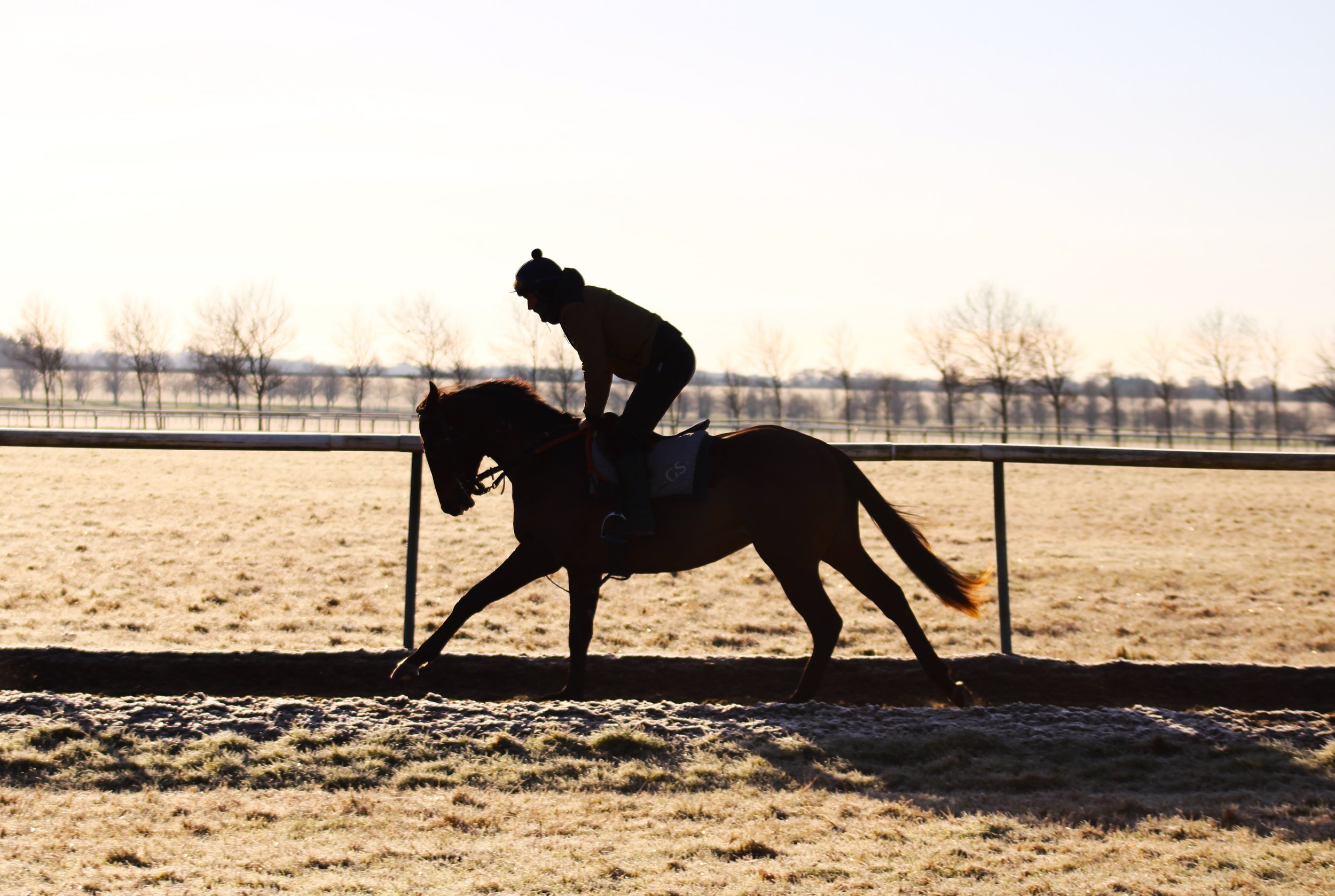
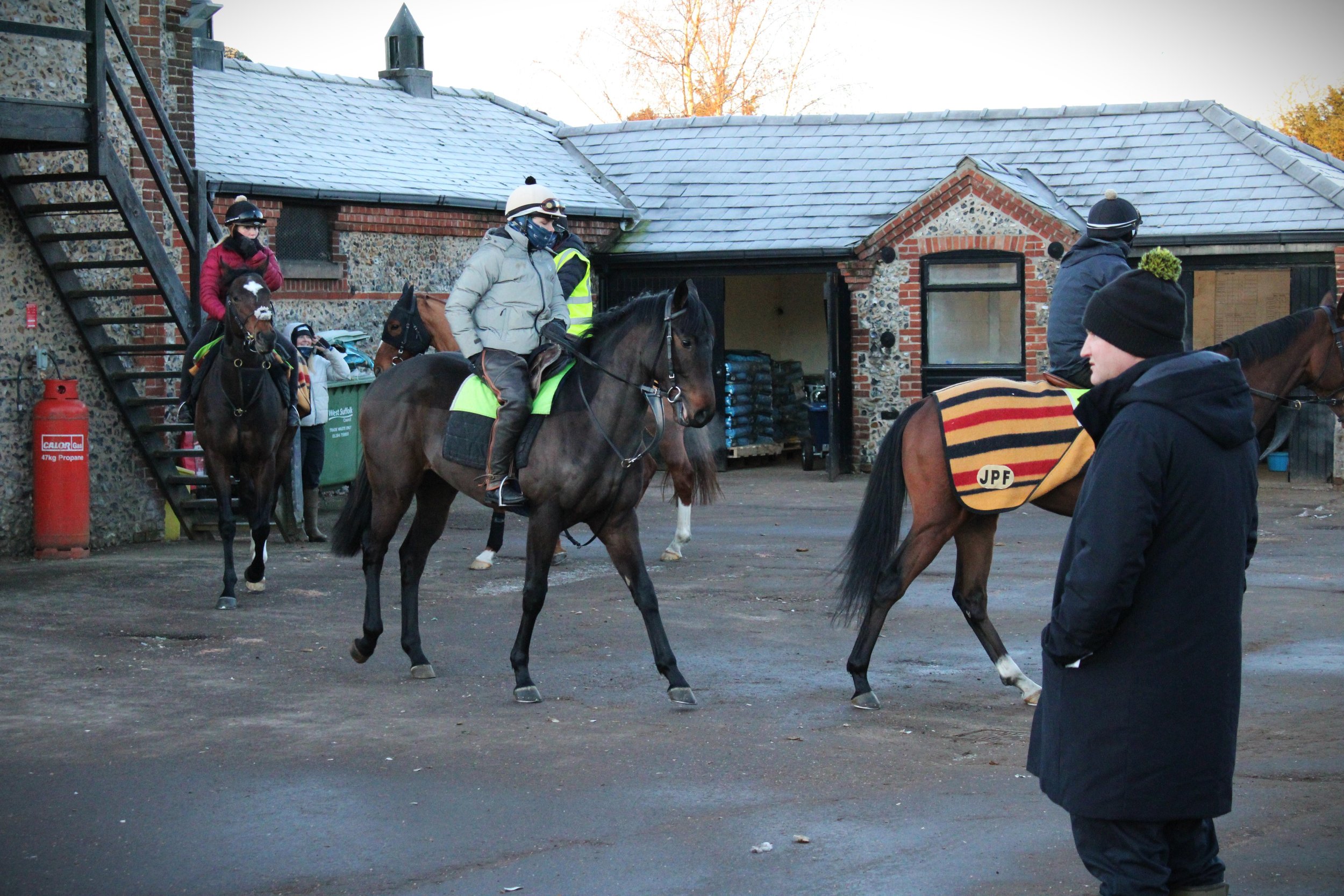
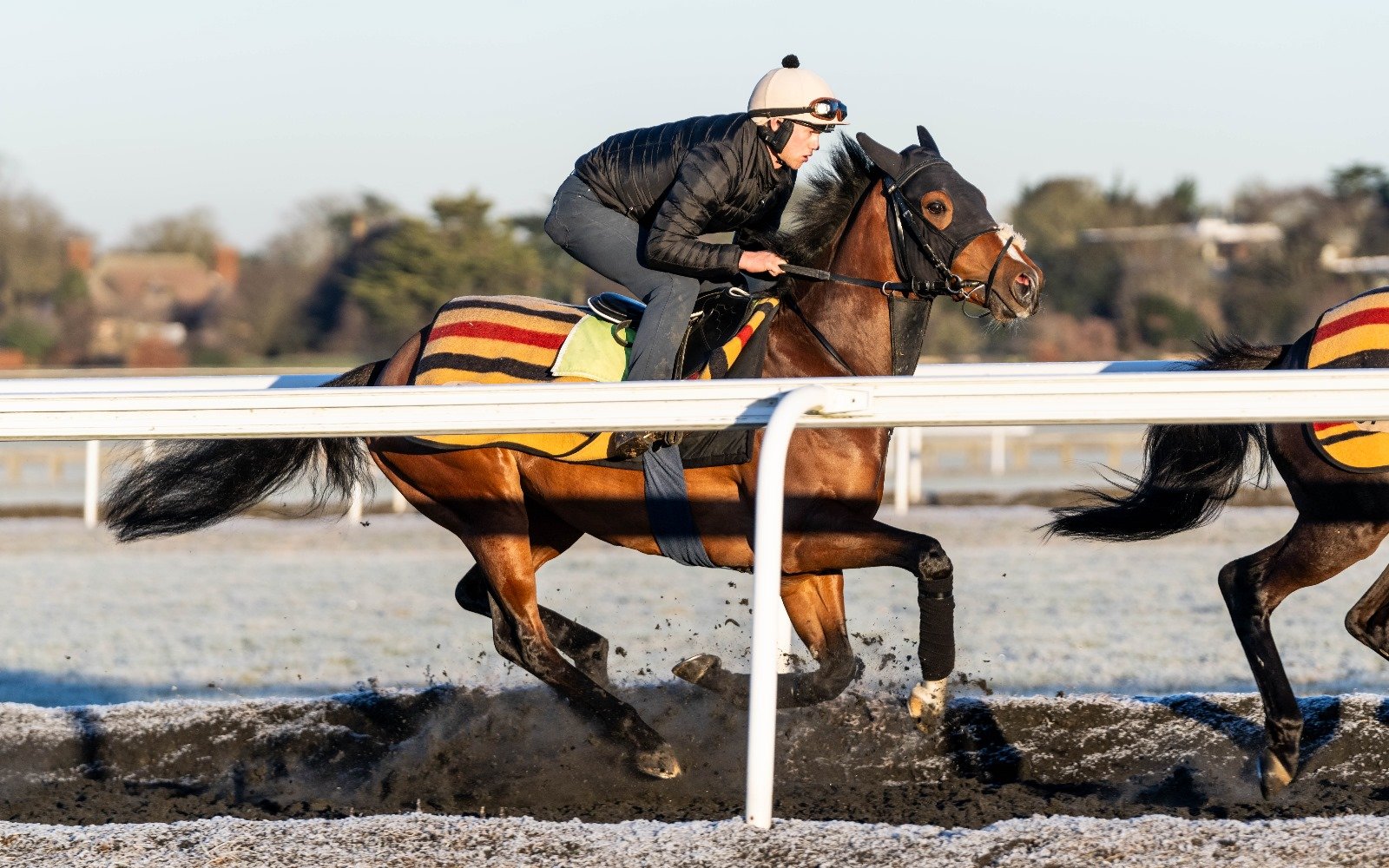
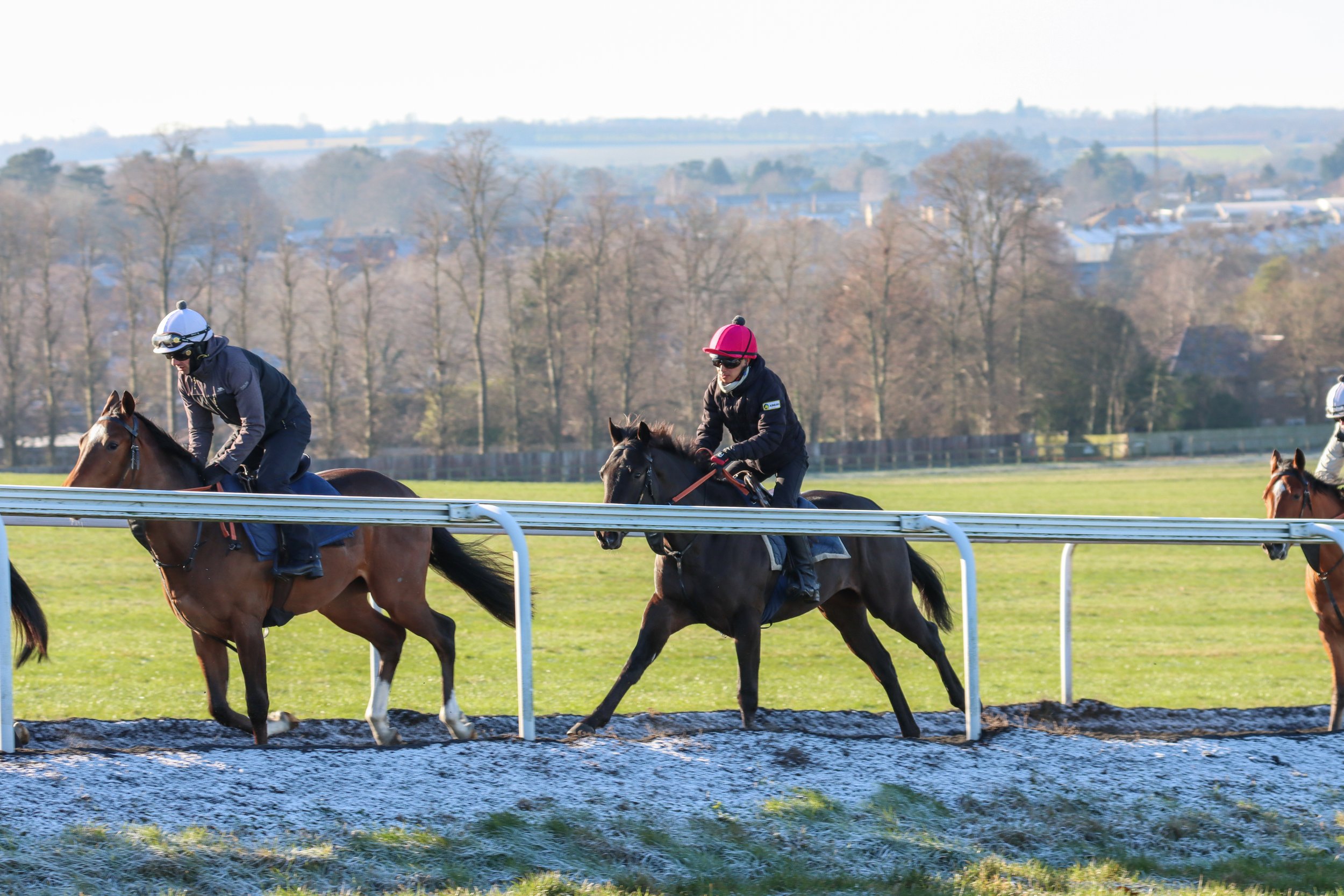
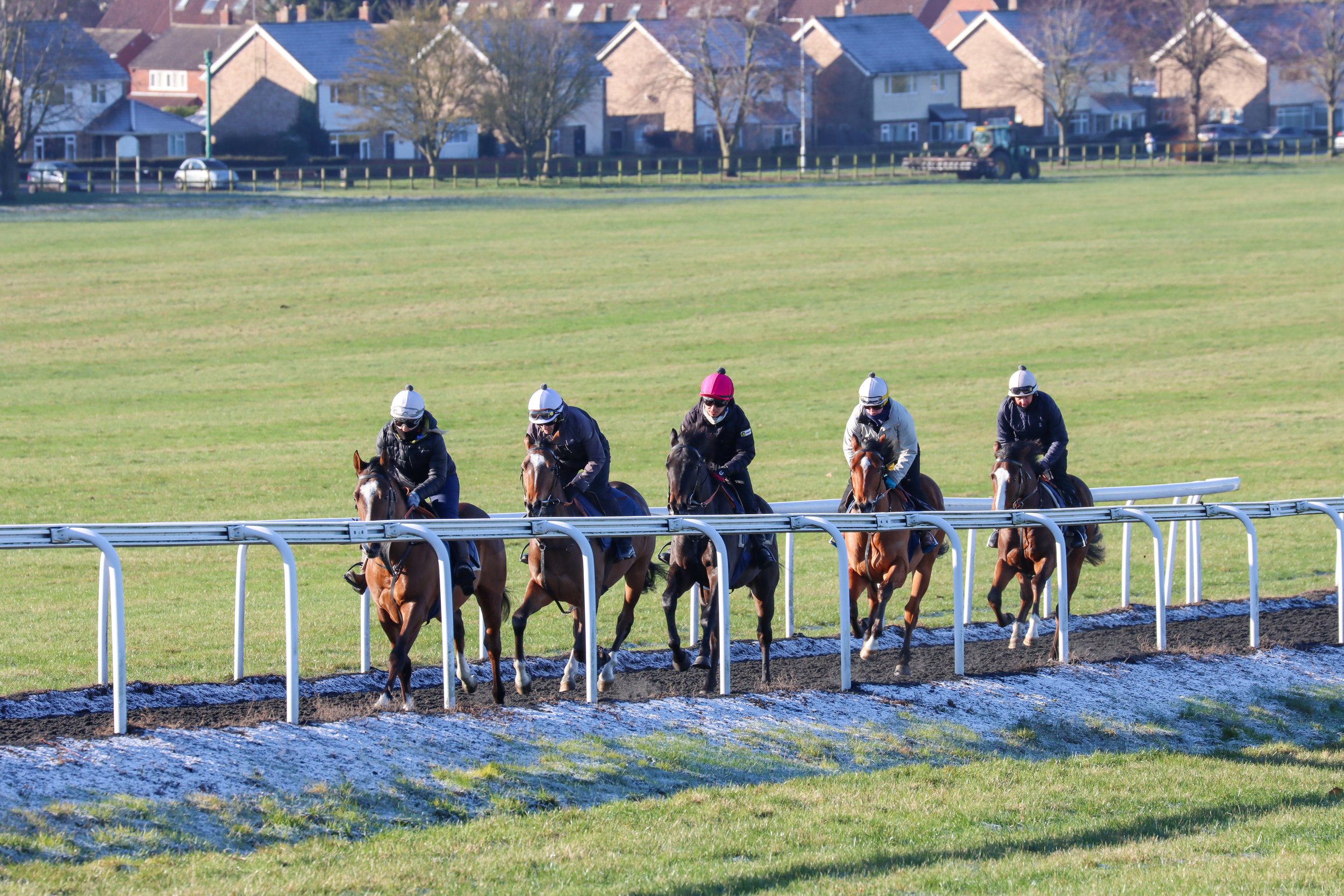
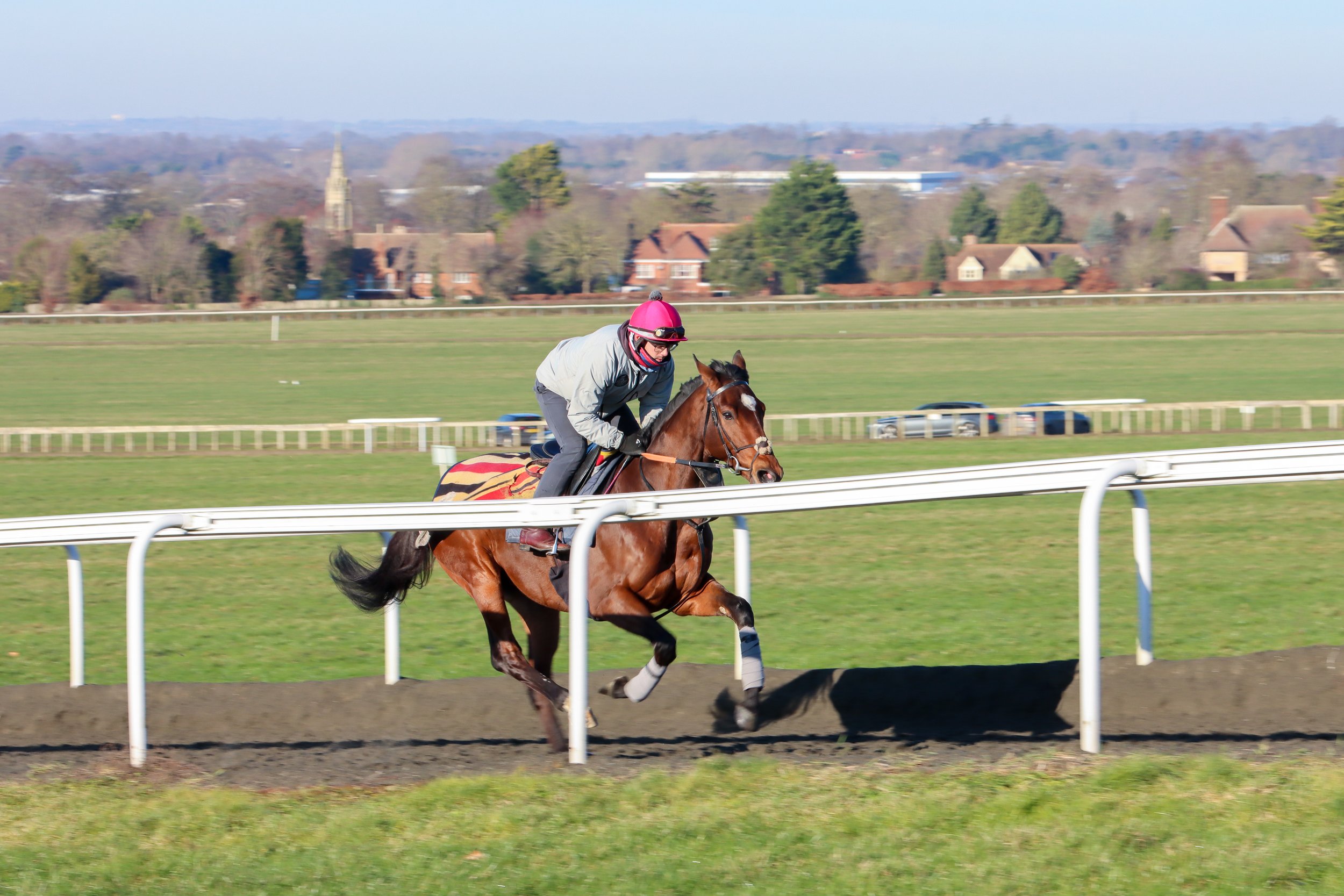
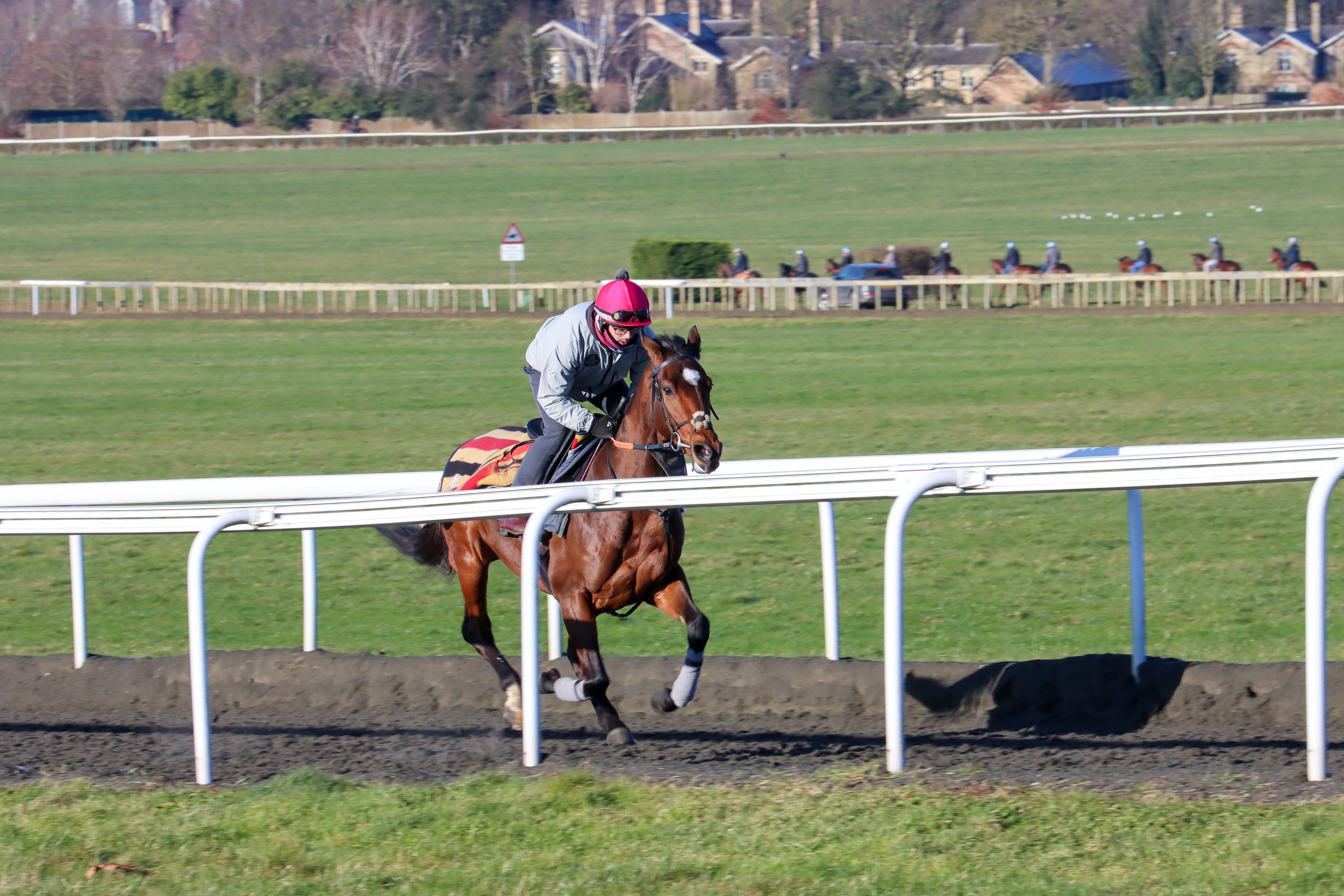
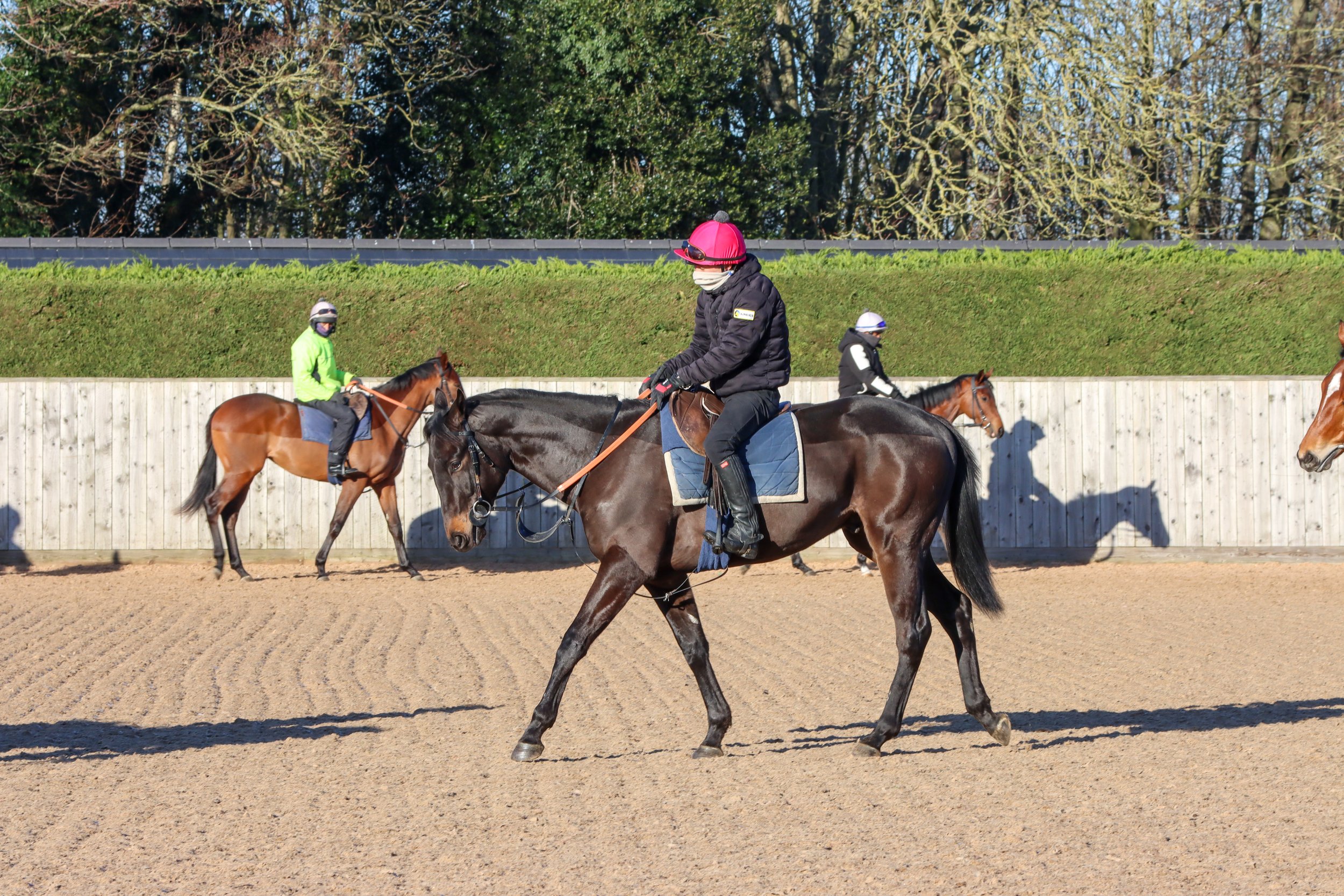
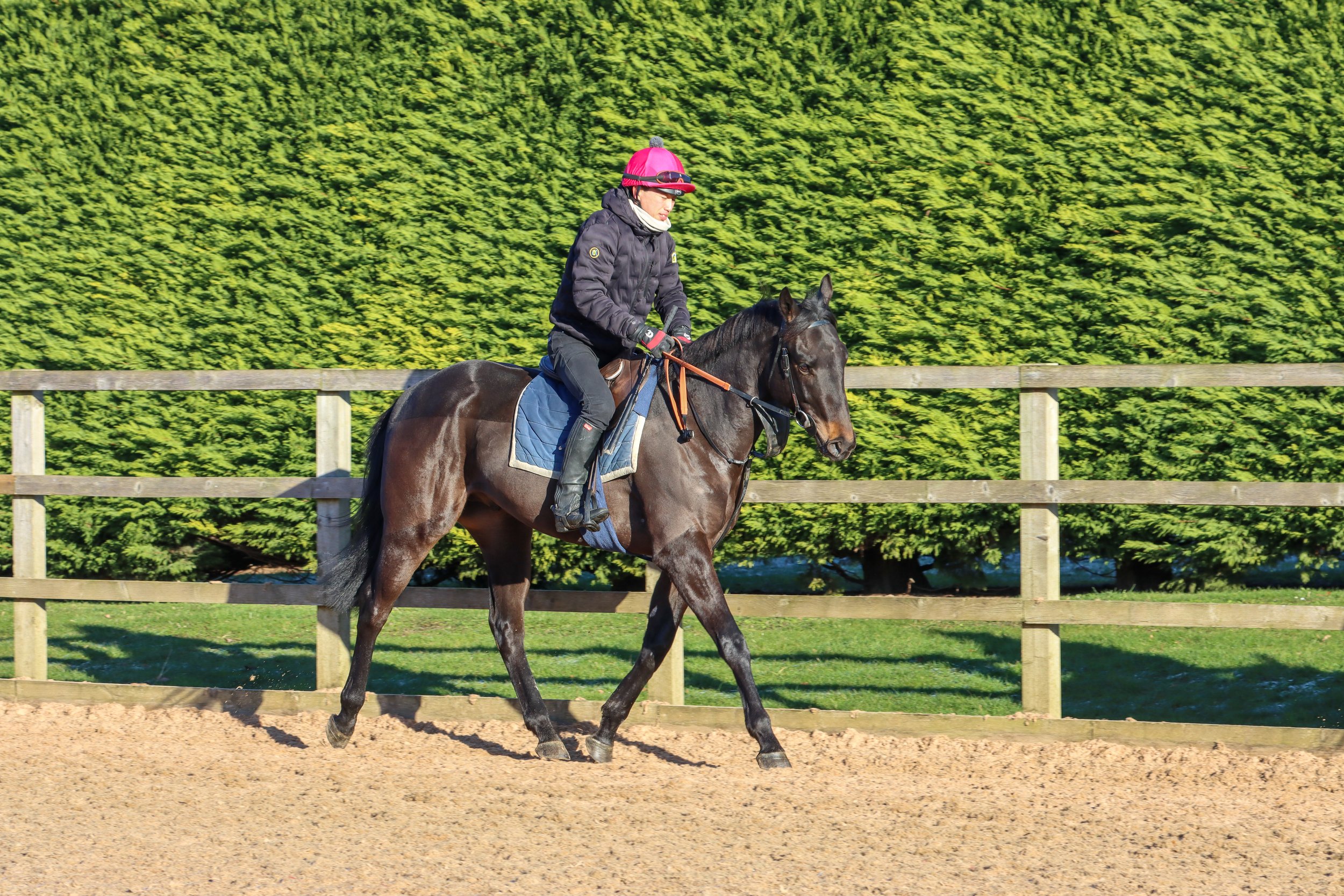
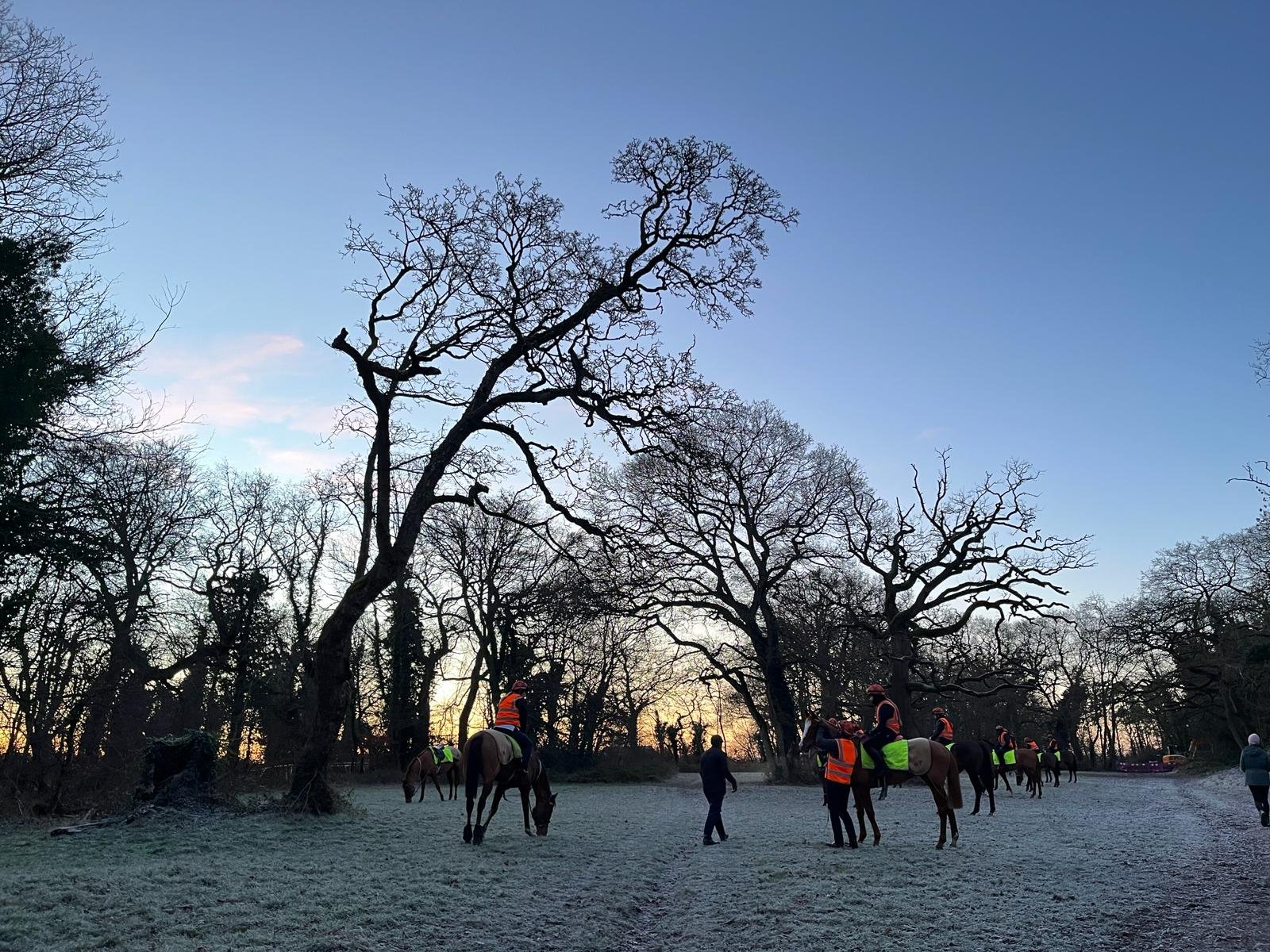
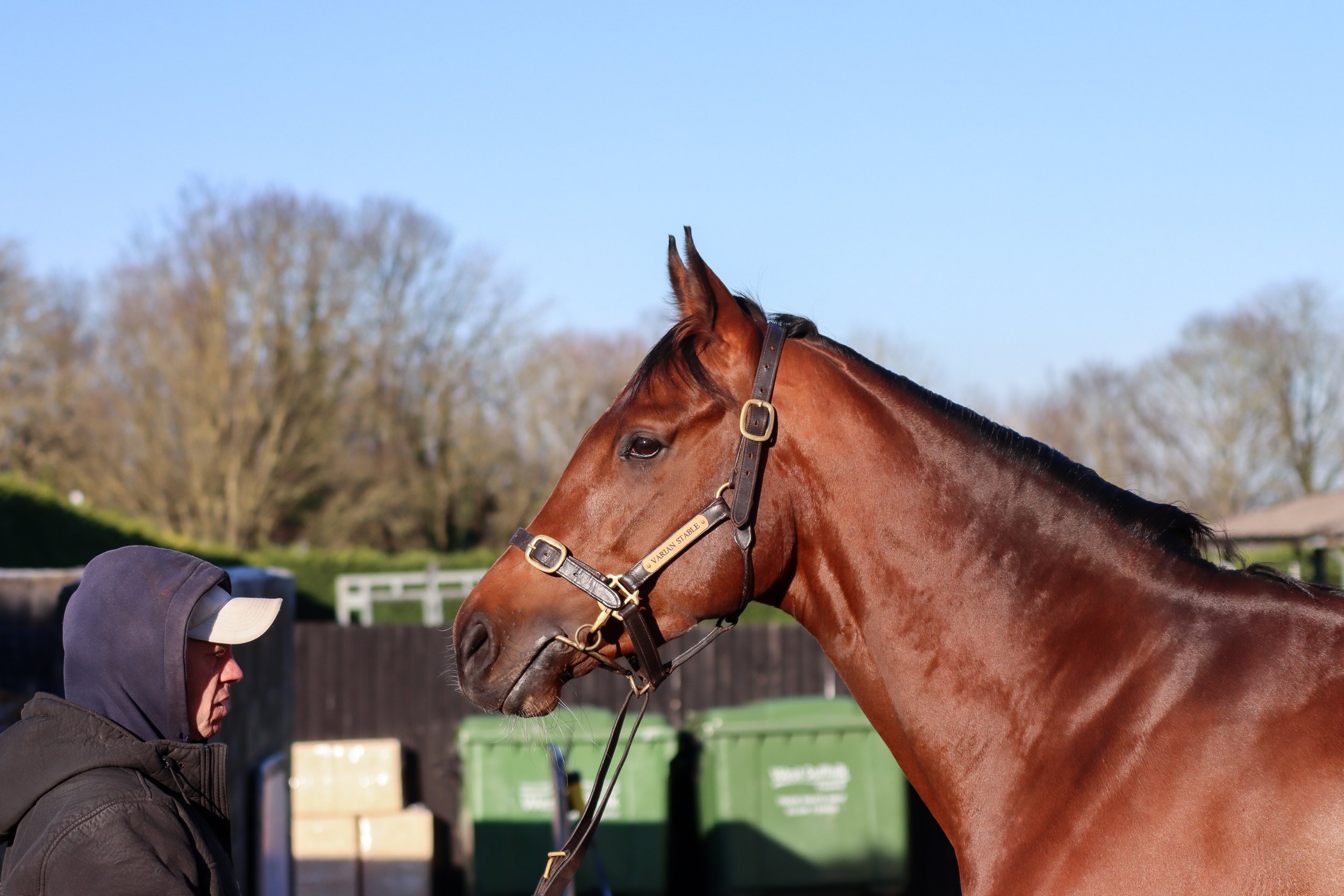
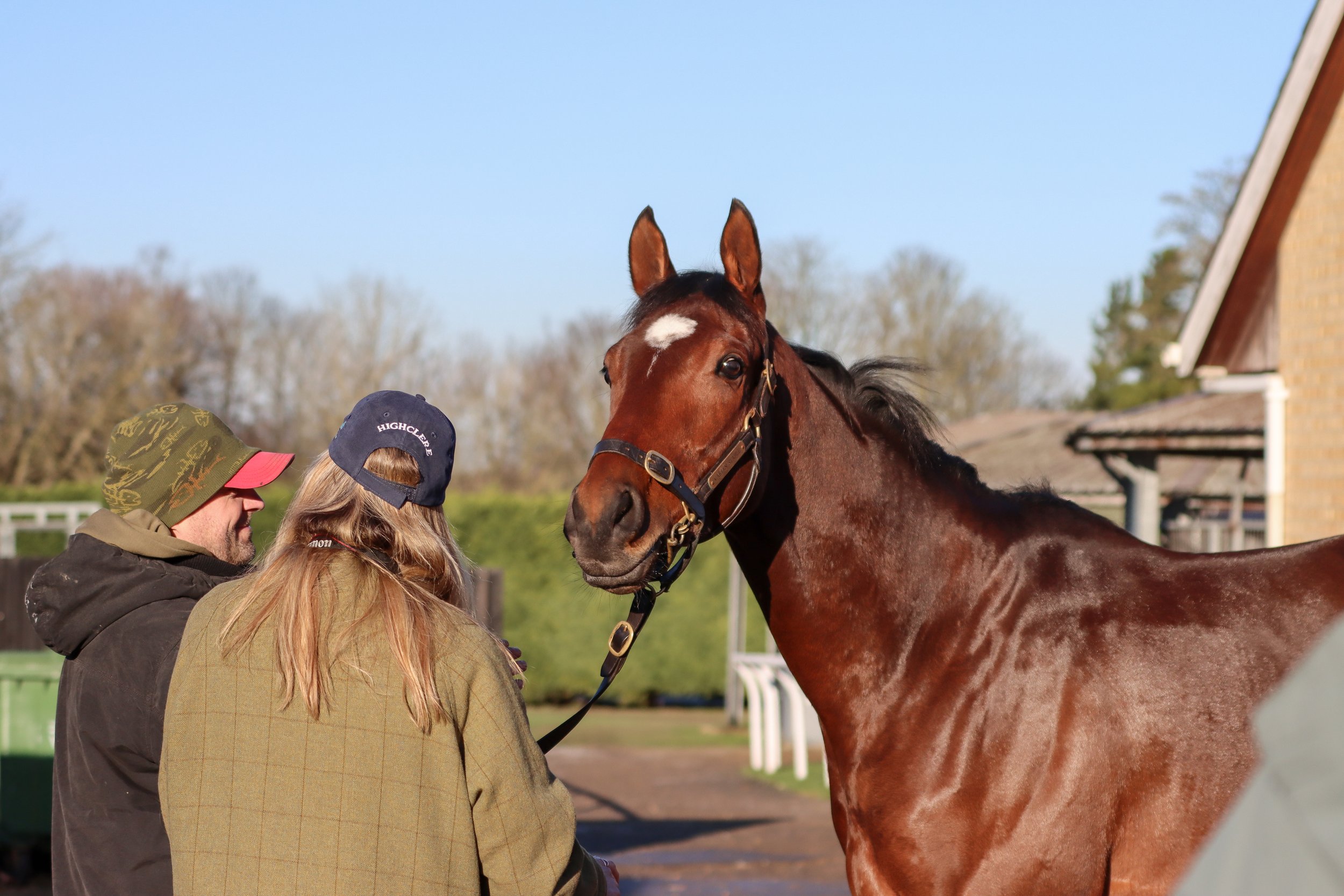
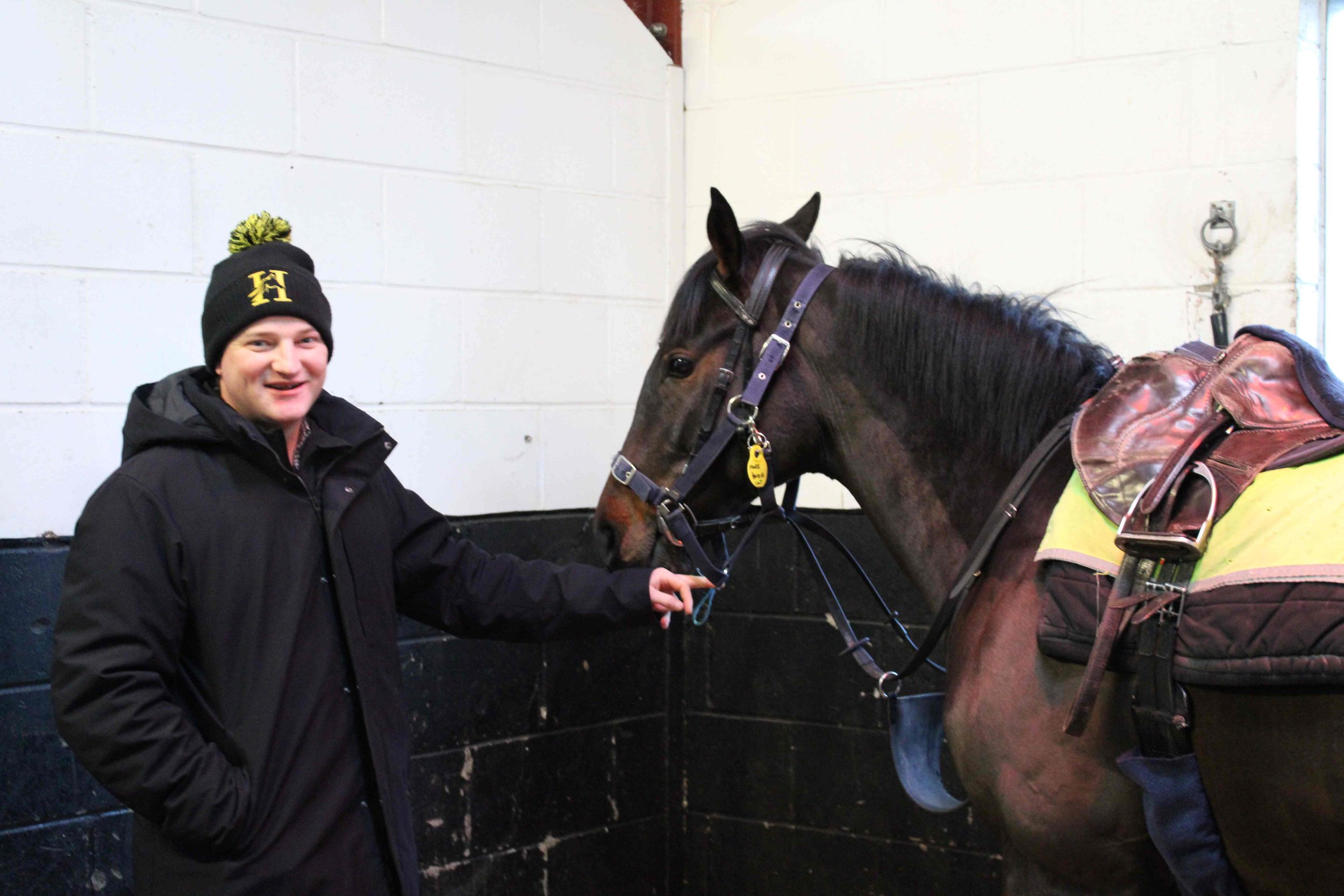

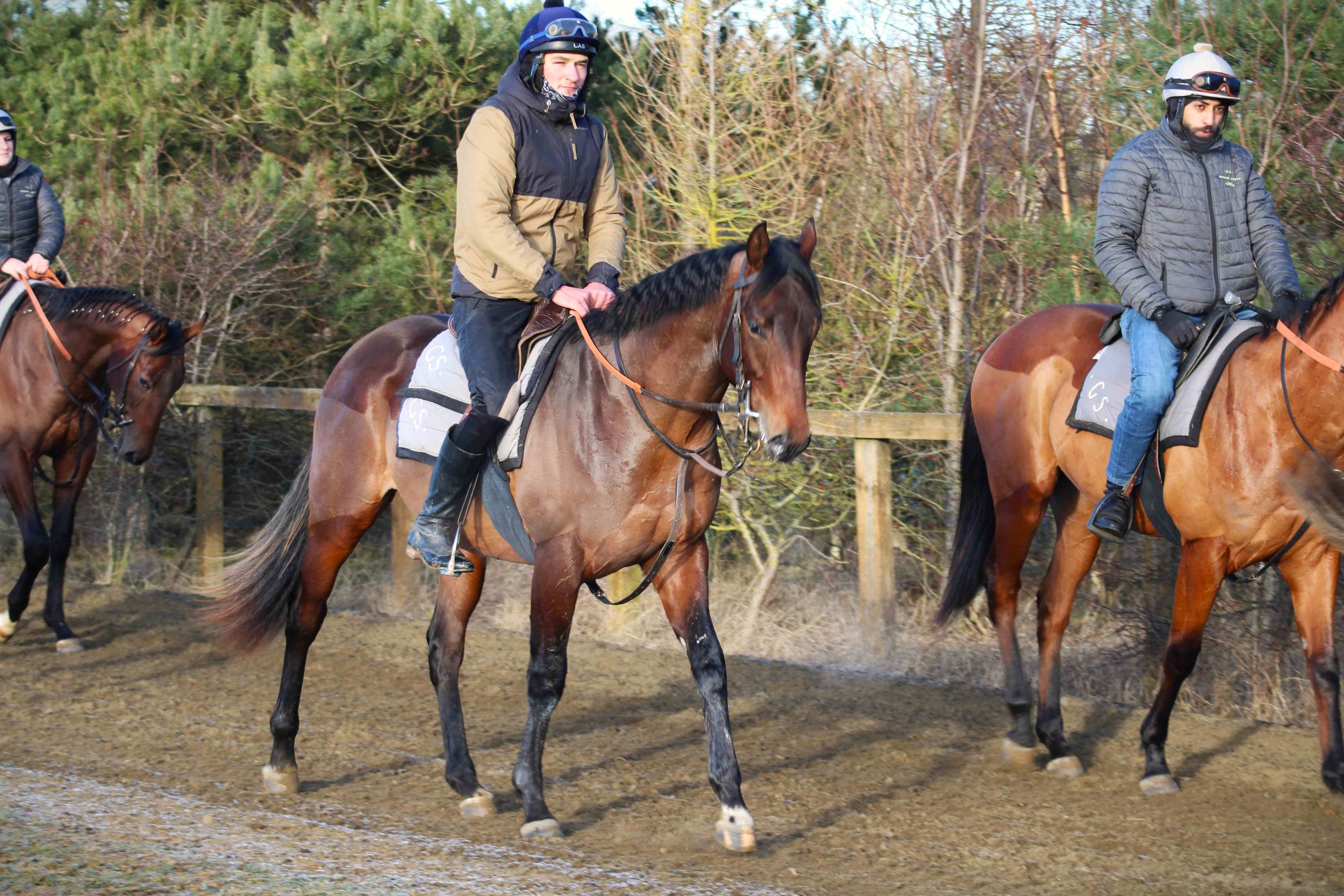
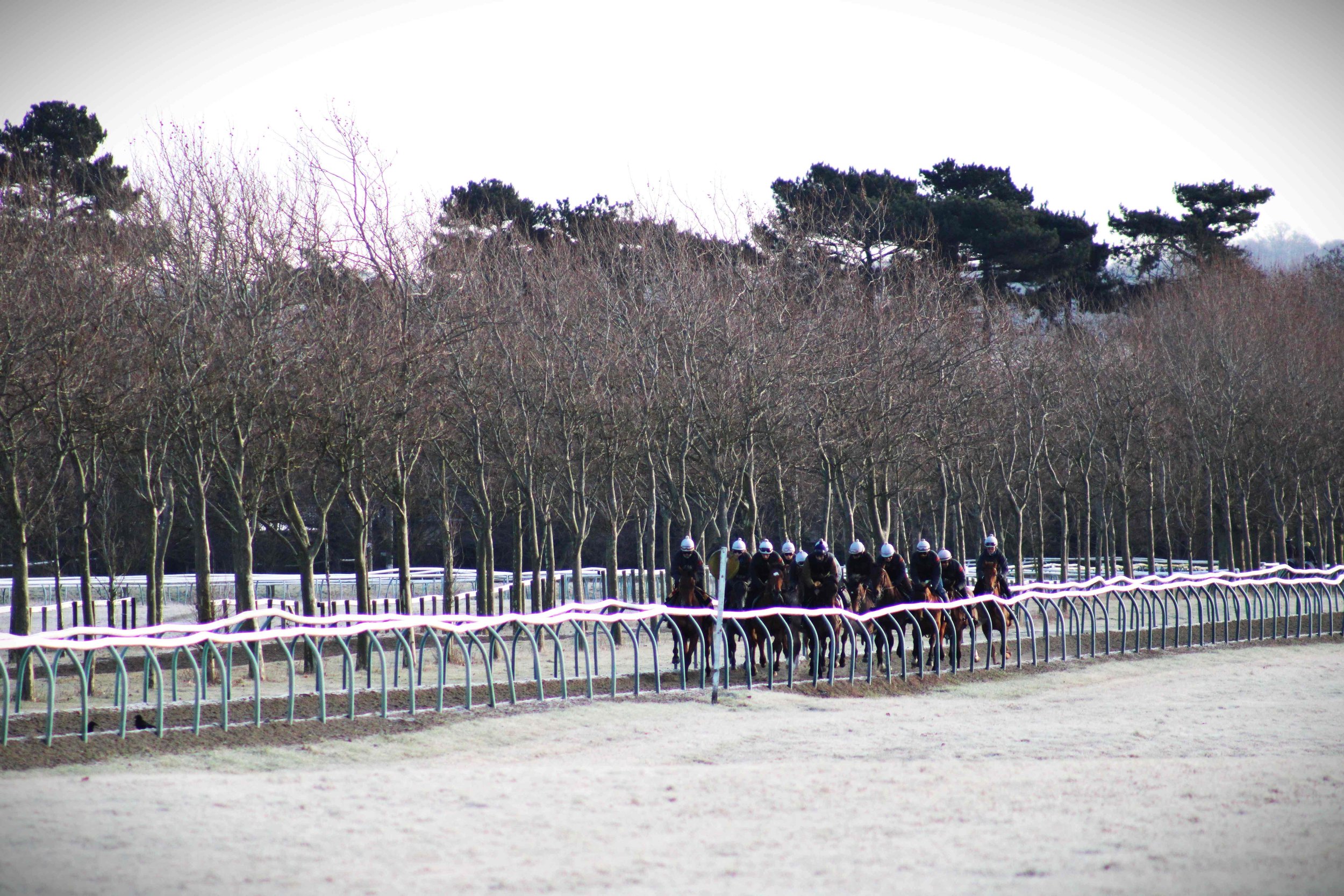
Guest editor
Emma Berry Editor TDN
Cheer Up, It Might Never Happen
Sunday, January 28, 2024 at 11:15 am | Back to: Europe, Shared News Europe
Updated: January 29, 2024 at 1:55 pm
By Emma Berry
We've never had it so bad, apparently. That of course depends on whether you're a glass-half-full or half-empty kind of person. Mine has been mostly empty so far in 2024, of the good stuff at least, but the swapping of a decent claret for chai tea has not lowered the spirits as much as might have been imagined at the start of January. In fact, optimism levels are running high in this very small corner of Newmarket at present.
For a start we have made it through storms Isha and Jocelyn with the loss of only one roof tile and a fence panel. There were no loose horses or fallers, and there has been no ice under the hooves of the fresh horses just back from their winter holidays. These sound like minor considerations, but in a small stable, when the horses who live below and the staff who come in every day to ride them feel like family members, every day that passes without dramatic incident is a good day.
‘What happened to that dream? Isn't it what drew people in in the first place, the chance to race a top horse?
There really is nothing like the thrill of being connected to a winner, whether in a syndicate or as a sole owner-breeder. That's the dream we should be selling, for no get-rich-quick scheme can equal that high’
Cracksman was available for £48 in 1968, according to this Stud And Stable advert
Don't get me wrong, I don't skip around every minute of the day being irritatingly upbeat. I have grave concerns over the way racing is heading in some areas, particularly that so many people seem willing to gamble on trading horses but have no interest in racing them. With little acknowledgement of their importance to the Levy, the paltry level of funding for lower-tier races is making it increasingly unsustainable for many of the sport's smaller participants to continue and is in part deterring others to get involved. It is becoming harder not to conclude that there is now no place for the small breeder, the small owner or the small trainer with their lesser horses. That would be a shame.
In the long history of sport, fans have deified the very best, and rightly so. We all need a Pele, a Piggott, a Klopp or a Cecil to sprinkle a little magic. But the sporting public also loves an underdog. Only recently, the exploits of Hewick on Boxing Day reminded us of this. And I long to see another horse of the ilk of Sergeant Cecil or Speciosa in the hands of trainers whose talents lack only the supply of horses.
For a start, what a story. Fresh faces, a new narrative. And then there's the knock-on effect; the hope brought to others in a similar situation, that encouragement to roll the dice.
Racing has always been built on dreams. People come and people go, and new people replace them with that same old dream. Retention is important, of course, and it is hard not to look upon last week's announcement from Andrew and Gemma Brown of Caldwell Construction with anything other than concern. Here are owners who have enjoyed major success, with some exciting young National Hunt prospects on their hands, withdrawing from racing and dispersing their stock, apparently following three recent fatalities among their string. One can sympathise with the Browns while wondering how long jump racing will be tolerated by the general public, particularly in Britain.
Among the other issues of the day are prize-money, concerns over Britain and Ireland becoming nurseries for other racing nations with deeper pockets, and the hoovering up of top-class stallion prospects by our friends in Japan. Well, guess what. None of this is new.
'No Racing and no Money as 1968 comes in' ran the cheery headline on the editorial leader in the February 1968 edition of Stud And Stable. Britain was then in the grip of a foot-and-mouth epidemic which had halted racing during the previous December (the same disease later caused the cancellation of the Cheltenham Festival of 2001). Remarkably, the December Sales of 1967 had been permitted to go ahead by the government under strict protocols and they recorded some notable returns despite some epidemic-enforced withdrawals. Sound familiar?
Vaguely Noble sold for a record 136,000 guineas, and he was far from the only high-priced lot to fall into the hands of owners from overseas.
The gloomy leader stated, “Already supported by racing programmes that justified the payment of high prices, French and American buyers were afforded a field day.”
It continued, “Throughout the century, England and Ireland have acted as a storehouse from which to supply the world's Thoroughbred requirements. This year's December Sales raised more dramatically than ever the question of how long we shall be able to go on doing so unless we can increase our prizes and keep the best at home.”
These words, written 56 years ago, could so easily have been penned today.
Elsewhere in the same magazine there was a short report on the sale of the stallions Larkspur and Hard Ridden to Japan, which began, “Following on from the rather alarming foreign purchases of the top lots at the Newmarket December Sales comes news of the export to Japan of two Derby winners.” Again, this has a familiar ring of recency to it (as did an advertisement in the same edition for Rathduff Stud's promising young stallion by the name of Cracksman).
In fact, the only thing that felt a little different in this edition of Stud And Stable from 1968 was a photograph of the packed stands at the Curragh in an advert for the Irish Sweeps Derby which boasted of the higher average prices of yearlings with Irish Derby entries. Just don't tell Patrick Cooper or he might write another letter.
Over the years we have had epidemics of the human and bovine variety temporarily halt racing in its tracks. It would have felt catastrophic at the time, and the worry of the months of April and May 2020 in particular is still fresh in the mind.
Somehow, though, this industry bounces back, often stronger than ever.
Racing limped on, restricted and reduced, through the far graver years of the Second World War. The Derby and the Oaks were run at Newmarket, but at least they took place. It must be said that the influential owner-breeders of the day played a major role in persuading the government that a certain amount of racing must continue for the morale of the people, not to mention the important continuation and testing of the breed on the racecourse.
And yet even in those desperate times we find in the Bloodstock Breeders' Review similar buoyancy at the sales, which is quite staggering considering what was taking place in the real world. A report written in the sixth year of war concluded, “Bloodstock Sales in 1944 showed the highest aggregate ever known…The December Sales results alone beat all hitherto established records…The same story is to be recorded regarding the Dublin Sales. All records were surpassed by the results in 1944.”
I've lost track of the times I've reported on a “record-breaking” sale over the last decade. Of course the vitality of the bloodstock market should not be confused with the overall health of racing. As stated, an increased number of people treat the sales like the stock market and are not involved beyond that, while plenty of money that changes hand comes from foreign investors.
That's not all bad though. We have always needed international interest in our bloodstock market, and the breed itself needs it. Many of those investors hail from countries which are not conducive to the breeding and rearing of horses, and the fact that the green and pleasant lands of Britain and Ireland are ideally suited to that pursuit has not gone unnoticed by those from overseas who have decided to establish their own breeding operations in this part of the world.
And yes, to a degree, it is facetious to imply that little has changed. Glancing through those old books and magazines, the most telling difference is that there were once so many small, independent studs that each stood a stallion or two. Now, many have been subsumed by those major investors whose breeding operations have become empires. Whether that is good or bad is almost a moot point. It's different, but we still have the choice of a large range of stallions, with many of the best in the world standing in these isles.
None of this means that we can simply think all is well and turn to complacency. Those quickly expanding racing programmes in the Middle East will need more and more horses to meet their demands, at a rate and standard which exceeds the potential of their local breeding industries. In part that is good news for European breeders, but it may well prove detrimental to racing here.
A personal gripe is how much owners appear to be encouraged to sell on a horse as soon as it shows a glimmer of talent. Obviously lucrative offers are hard to turn down, and horses can suddenly be lame in the blink of an eye, so this isn't pointing the finger of blame at anyone who has cashed in. But what happened to that dream? Isn't it what drew people in in the first place, the chance to race a top horse?
There really is nothing like the thrill of being connected to a winner, whether in a syndicate or as a sole owner-breeder. That's the dream we should be selling, for no get-rich-quick scheme can equal that high.
The politics of racing can certainly detract from our enjoyment of the sport if we let it. So it's time to stop doom-scrolling. Put down your phone and get yourself out to a paddock or a racecourse to marvel at the beauty of the Thoroughbred. The start of the Flat turf season is now but two months away and the foaling barns are once again filling up with the stars of the future.
If we get it right now and treat these wonderful creatures with the respect they deserve throughout their lives, then there is hope that in another 80 years the bloodstock journalists of the future will be writing about yet more sales records and why the Irish Derby should remain at a mile and a half.
Where Are They Now?
by Sarah Ward
This month we catch up with Distinction, fondly known as Big D. We worked out that in his racing career, he ran over 60 miles and retired sound as a pound in 2008. Amazing to have run in 35 races, winning 8 in total. 23 of these 35 were Stakes races and six of these he won. The mileage he covered equates to travelling twice to Melbourne! His roll of honour includes finishing second in the Ascot Gold Cup when it was run at York. He also finished sixth to Makybe Diva in the 2004 Melbourne Cup and finished third to Yeats in the Ascot Gold Cup (Gr 1) in 2006 along the way too!
Big D spent his early retirement years leading the string for Sir Michael Stout before being moved to continue his retirement under the care of head girl Sarah Deniff. In 2017, he spent a few months post Freemason Lodge at the ex Jim Joel Childwickbury Stud in Hertfordshire before travelling to his forever home in Ireland with Sarah’s friend Louise. He now lives in Slievehanny, in the hills of County Down overlooking Dundum Bay and the beautiful Mourne Mountains. He enjoys a paddle in the sea at Tyrella from time to time! Louise says that Big D is very special to her and her family, especially her children who absolutely adore him so it is lovely to hear that he will live out the rest of his days in such wonderful surroundings.
Clodagh’s recipe
by Clodagh McKenna Herbert
Spicy Sausage Fettuccine with Crispy Sage
Serves 4
INGREDIENTS:
500g fettuccine
400g hot Italian sausage
24 sage leaves
3 to 4 tablespoons olive oil
1 clove garlic, crushed
300ml cream
sea salt and freshly ground pepper
Freshly grated Parmesan
METHOD:
Fry the sage leaves in olive oil in a frying pan until they are crisp. Drain them on paper towels, chop and set aside.
Chop the sausages into small 2 inch pieces and sauté them in olive oil until the sausages are browned, adding the garlic towards the end so that it gets golden but not burned. Pour in the cream, season with salt and pepper and simmer for 5-8 minutes.
Get a large pot of salted water on the boil, and cook the fettuccine. Spoon a few tablespoons of the pasta cooking water onto the cream sausage sauce.
Drain the pasta and fold it to the sauce off the heat. Add lots of grated Parmesan cheese.
Toss and sprinkle with the chopped crisped sage leaves.
Rolf’s Rambling’s
By Rolf Johnson
There’s a joke, a wicked one, that it would be heavily ironic if a Hindu and a Muslim – the current Prime Ministers of England and Scotland - orchestrated the partition of the UK, given that we Brits split India (Hindu) and Pakistan (Muslim).
The strength of ties between the sub-continent and Great Britain has survived all manner of turmoil since we disbanded the Empire in 1947. British tourists swamp India – where they speak English.
The dividing line we slashed across the map stranded India’s principal thoroughbred studs in Pakistan, including the premier establishment, Renala in the Punjab. Yet horseracing prospered in India – until recent times.
When the popular weekly BBC Radio 4 programme Last Word, recording notable deaths, recently featured Anne Wright, mainly for her work in tiger conservation, it completed overlooked that she was the last Briton to own and run a racehorse stud in India, Lingwood, an hour south of Delhi.
Paul Scott’s masterly novel Staying On described the last crumbling days of ancient Brits who ‘stayed on’ after Independence: India was all they knew. Anne Wright, young daughter of one of the last British members of the Indian Civil Service, stayed on, until her death at 94, through choice.
As did another Englishman, Sam Hill, the first trainer ever to saddle every winner on the card and who, up to his death in 1993, ran the stud at the Maharajah of Mysore’s Summer Palace in Bangalore.
These two ‘remainers’ served Indian racing well though some would claim the game’s heyday came earlier in the twenty first century when once there were over one hundred tracks. They would have eschewed the description ‘expat’: nowadays the late Sir Henry Cecil’s stepson James McKeown ploughs a lone furrow in Chennai (Madras).
And today there are nine courses for sport which has many more powerful enemies than friends.
Foreign jockeys, before the counter attractions of winter all-weather racing and jet-setting, queued for lucrative contracts to ride for Indian royalty. Lester Piggott rode his second last Group One winner there; Frankie Dettori had a stint; Richard Hughes in 2010 rode Jacqueline to win all the classics and now trains for the mare’s owners, Khushroo Dhunjibhoy and Vijay Shirke. Jacqueline herself went to produce winners at Coolmore.
Hughes’s was a unique feat which might be emulated by Oisin Murphy who rode the Indian One Thousand Guineas winner Jendayi (Gleneagles out of a Nayef mare) in the green, red and yellow Jacqueline colours in December (three-year-olds) and this January, the Indian Oaks. The £200,000 Indian Derby, held on the first Sunday in February at Mahalaxmi racecourse Mumbai, is Jendayi’s objective.
It’s easy to blame Gandhi for racing’s downfall in India. He was revolted by gambling due partly to his own early unsuccessful attempts, amplified by the reckless wagering of his prodigal son Harilal who was reduced to penury.
Indian Governments blithely invoked the Mahatma’s name whenever they wanted a stick to beat racing. The British Government likewise sees votes in patronizing gambling’s lost souls projecting the spectre of ‘affordability checks’. Just as ruinous to the sport is the Indian Government ’s 28 per cent tax on racing bets.
Indian punters have set the example for ingenuity finding ways round the oppression: hardly surprising given the enterprise that has enabled the most populous nation on earth to overtake us as the fifth highest ranked country in the world, reckoned by GDP.
Indians bet, and how they bet, on the black market. To a lesser degree punters and bookmakers turn up in numbers at their racecourses when there is no meeting on; events are relayed on screens from the live venue of the day. I wonder what such punters would make of my stepping into a British betting shop lately, and saw they were showing the 11.20 from Mysore. Nobody else took notice so, for old time’s sake I asked for £10 on the second favourite. I was refused.
In the ‘old days’ on Indian tracks there was one ‘discontinued’ practice that had more ‘class’ than the mobile phone ‘escape route’ of today. One’s peon was sent to the win queues at bookmakers or the Tote to tap on shoulders and offer a larger amount than the successful punter’s winnings. Along with the cash the servant returned with the all-important record of the bet – taxman trumped.
The leading studs still covet British and Irish bloodstock, and their agents are perennials at mares in foal Sales. The list of ‘got abroads’ as opposed to pure India breds continues to outstrip the latter on the rolls of honour. The latest stallion to find his way to India is Chindit, from the Richard Hannon stable, to the once all conquering Poonawalla Studs. And the ‘first Frankel’, Baratti, runner-up to Alpinista in the Grand Prix de Saint-Cloud, stands there too.
Cyrus and Zavary Poonawalla built the Serum Institute in Pune, the largest producer of vaccines in the world, including anti-Covid. The brothers are dedicated to regaining their former domination of Indian breeding through British stallions such as Placerville (Mr Prospector) and Alnasr Aswasheek (Sadlers Wells). The second of Frankie Dettori’s Ascot Magnificent Seven, Diffident came out with fanfare to Poona, without adding much to his distinction.
Then came the almighty Razeen, once Sheikh Mohammed’s favourite for the Derby (Quest for Fame). Singlehandedly he took Usha Stud founded by the President of India’s bodyguard Major P K Mehra in 1973, to a string of titles. The formerly Sir Henry Cecil trained Multidimensional took over from Razeen.
Arguably Usha’s greatest single achievement was to breed the first four in last year’s Indian Derby. Visit the Elysian fields of Usha, not far from Lingwood, and you’re bound to return to the verdant pastures of India’s pre-eminent, world renowned, thoroughbred stud farm.
Royalty, Sheikhs, Presidents, racing nobility (and commoners – myself included), beat a path to Usha to witness for themselves this exotic equine haven. The story of the fabled 1939 Hollywood blockbuster, The Wizard of Oz, is that if you stay true to yourself and continue on the right path, the Yellow Brick Road, it will lead to good outcomes. The heroine, Dorothy is the personification of American values: as is the equally redoubtable Ameeta Mehra of India’s.
Ameeta describes her life as “One long drive.”
Anyone suggesting the correspondence between Dorothy and Ameeta is contrived need look no further than this coincidence: as a young girl Dorothy finds herself in a strange fantasy world, the consequence of the untimely death of her parents. In the real world, after the calamitous loss of her parents and sister in a helicopter accident in 2001, Ameeta Mehra was obliged to take on the established order in India, singlehandedly.
She has survived the untimely departures of three of her top clients. “Dr Ramaswamy, Deepak Khaitan and Vijay Mallya would have taken, every year, the biggest portion of a hundred or so of my youngsters.” And so her outlook is philosophical. “Today everybody in our racing is taking a beating. Twenty stud farms have closed in the last five years.” Ameeta has more to lose than anyone yet while the foal crop is in decline the value of her bloodstock rises.
2023 was Usha’s Golden Jubilee year, the 50th anniversary of the farm’s foundation. That fabulous Derby charge at Mahalaxmi was led home by her filly Mirra, running in Ameeta’s own yellow and blue colours and named for The Mother, Mirra Alfassa, inspiration for Ameeta’s own devotional journey.
Racing in India suffers from the same political deception that beset the sport for too long in the UK. Despite the Indian High Court following the lead of ours decreeing that betting on racing “is a game of skill” it is daubed as an elite activity with only windfall (illicit) gains. In the real world racing’s followers are people of all classes – and in India, of all castes.
Ireland’s almighty Coolmore operation (which fielded first three home in the 2016 Prix de l’Arc de Triomphe) recognised the enormity of the achievement of Usha in last year’s Indian Derby and are observing, all the more closely, the progress of Usha’s new stallion Deauville, son of their incomparable Galileo and a Group race winner in England, Ireland and the USA. Deauville’s first progeny will shortly grace the Indian turf.
The Highclere-Usha connection will strengthen over the years. Harry Herbert was asked to share his own “unforgettable trip” to Usha for the Stud’s Golden Jubilee album.
“I have such fond and happy memories of Ameeta’s beautiful farm,” said Harry. “The invitation by Ameeta Mehra was the highlight of my visit to India for the Asian Racing Conference in Mumbai. Naturally I compared the organisation and atmosphere of Usha with our family stud at Highclere and I concluded that here was a world class operation – we could have been twinned! I started the day with a meditation in the Gnostic Centre – and then my breath was taken by the stunning parade of stallions, mares and offspring - transporting me to our own parades back home. Surely some, at least, of these remarkable youngsters would hold their own on an international stage? I would like to congratulate Ameeta on Usha’s Golden Jubilee and wish her ever more success in the years ahead.”
Taittinger Moment
Ken Hardman
This month’s Taittinger Moment has been awarded to Ken Hardman, who we discovered shares the same January birthday as Defiance. Happy Birthday Ken and Defiance! Hopefully you both enjoyed some birthday cake and extra carrots…!
